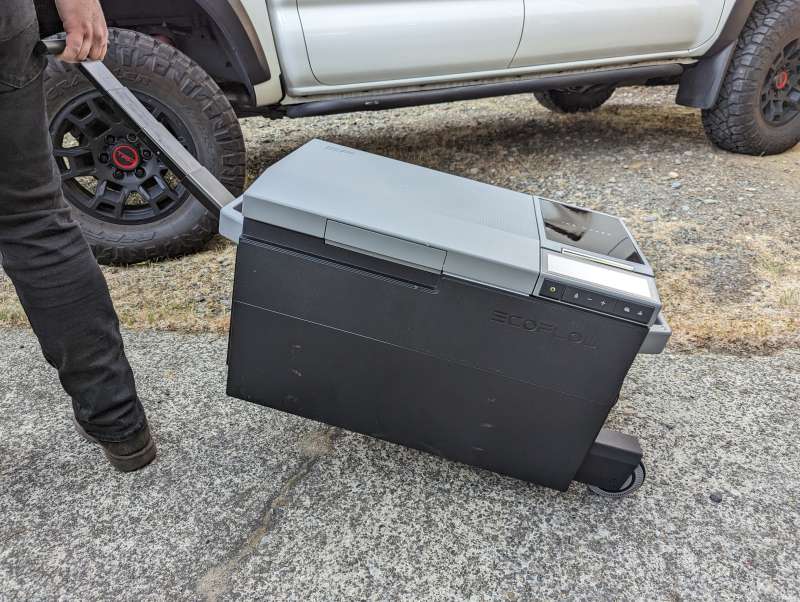
REVIEW – As camping season approaches, I’ve been looking for ways to stay out in the wilderness a bit longer. So, I’m dipping my toes into yet another expensive hobby, overlanding. Overlanding is all about exploring remote and rugged areas using off-road vehicles for extended periods of time. To that end, I’ve been researching portable refrigerator/freezers to keep food fresh for me and my pup in the wild.
Most overlanding fridge freezers cost anywhere from $500 to $2,000 and are designed to handle a lot of abuse. Recently, I tried out the EcoFlow Glacier portable dual-zone refrigerator/freezer, which has a lot of high-end features that will make life more comfortable on the trail—it’s just not as rugged as I’d hoped. But it does boast a built-in ice maker, dual-zone cooling, and full app control. With the accessories I tested, the EcoFlow Glacier comes with a price tag of around $1,300. Although it may seem a bit steep, it’s evident that a considerable amount of effort went into the intentional design, app functionality, and features of the Glacier. While the Glacier may not be as durable as some other options, it’s perfect for car camping or keeping drinks and snacks cool by the poolside.
What is it?
The EcoFlow Glacier is a 38L 3-in-1 portable dual-zone fridge, freezer, and ice maker. The Glacier has a 120W compressor, allowing it to refrigerate and freeze items from 50°F (10°C) to -13°F (-25°C). A removable rechargeable 298Wh battery, which is sold separately, allows the Glacier to function for up to a reported 40 hours wire-free. The battery can be used to power other devices as well like phones or laptops via a 100W USB-C port. EcoFlow also provided a wheels and handle kit for increased mobility.
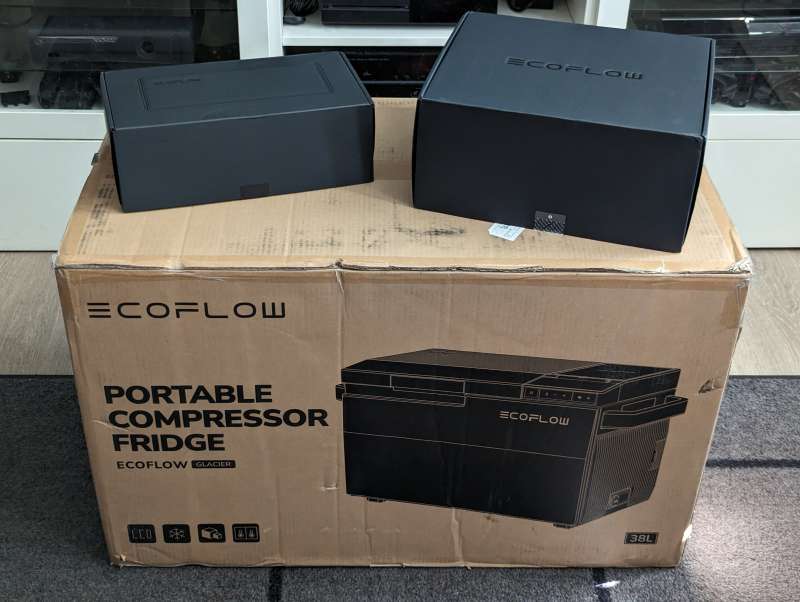
The EcoFlow Glacier ships in a basic cardboard box with an illustration of the unit on the front. Both the rechargeable battery and wheels and handle kit ship separately in black boxes with the EcoFlow logo embossed on the top.
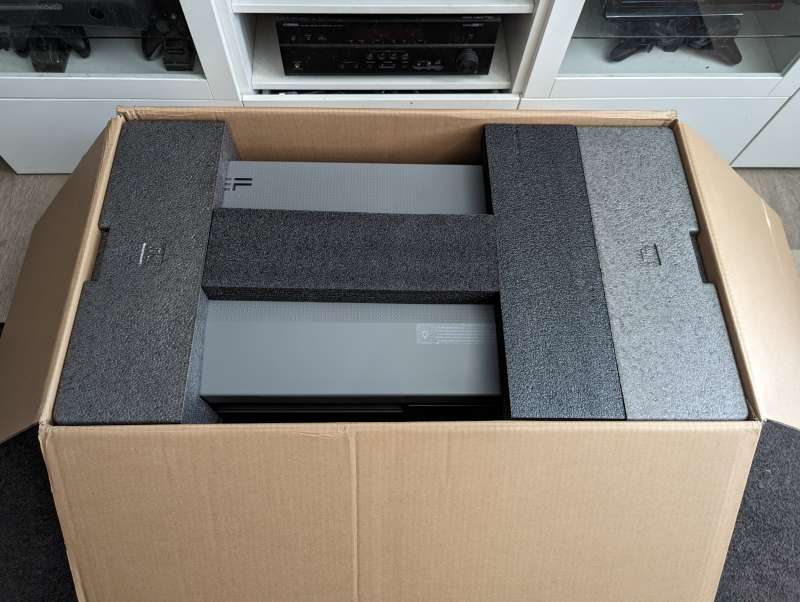
What’s in the box?
- EcoFlow Glacier Portable Refrigerator
- AC power adapter and cable
- Glacier Plug-in Rechargeable Battery
- Car charging cable
- Left zone basket
- Ice shovel
- Quick Start Guide
- Glacier Wheels and Handle Kit
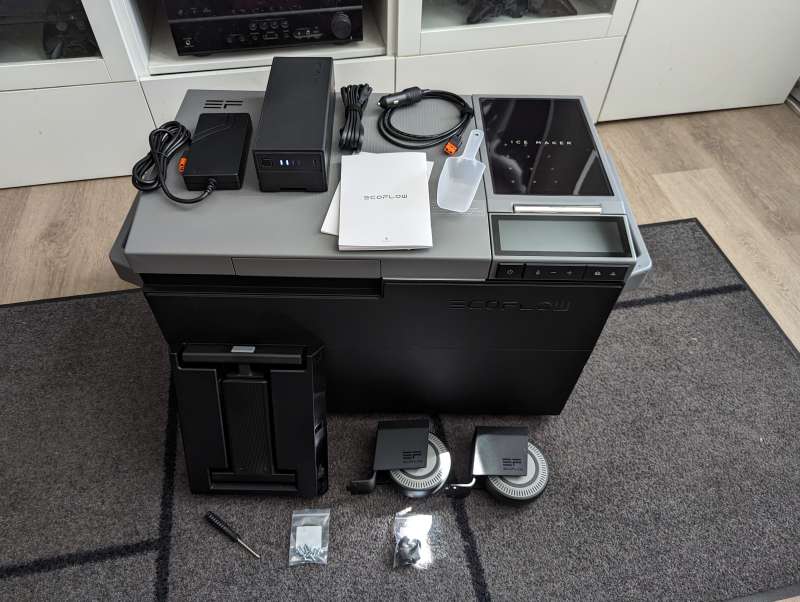
Hardware specs
- Operational Volume:
- Single zone: 38L (40 qt.)
- Dual zone:
- Left zone: 23L
- Right zone: 15L
- Net weight: 51.4 lbs. (23.3 kg)
- Dimensions (L × W × H):
- 30.6 × 15.2 × 17.5 in. (776 mm × 385 mm × 445 mm) – Without wheels and handle
- 33.6 × 15.2 × 17.5 in. (852.4 mm × 385 mm × 445 mm) – With wheels and handle
- IP rating: IPX4 – Protects from splashing water from any direction
- Modes:
- Quick freezing mode
- Eco mode
- Quick Freezing Mode Timing: 86°F to 32°F – 15 minutes
- Compressor power rating: 120W
- Power consumption:
- Fridge: 0.18 kWh/24 h
- Freezer: 0.38 kWh/24 h
- Refrigeration Temperature Range: –13°F – 50°F (–25°C – 10°C)
- Refrigerant type and amount: R600a, 32 g
- Noise Level:
- Ice making: <52dB
- Refrigeration: <42dB
- Wi-Fi: 2.4 GHz Wi-Fi only
- Bluetooth: Supported
- Power Input:
- AC Input: 100-240V, 50/60Hz, 180W
- Solar Charging Input: 240W (11-60V, 13A Max)
- DC Car Charging Input: 12/24V, 10A Max
- Battery Pack Power: 100W (USB-C)
- Operating temperature: -4°F – +122°F (-20°C – +50°C)
- Storage temperature: -4°F – 140°F (-20°C – +60°C)
- Plug-in Battery:
- Net weight: 4 lbs. (1.8 kg)
- Capacity: 298Wh
- Cycle life: 800 cycles to 80%
- Dimensions: 9.7 × 3.6 × 2.7 in. (245.5 × 92 × 68 mm)
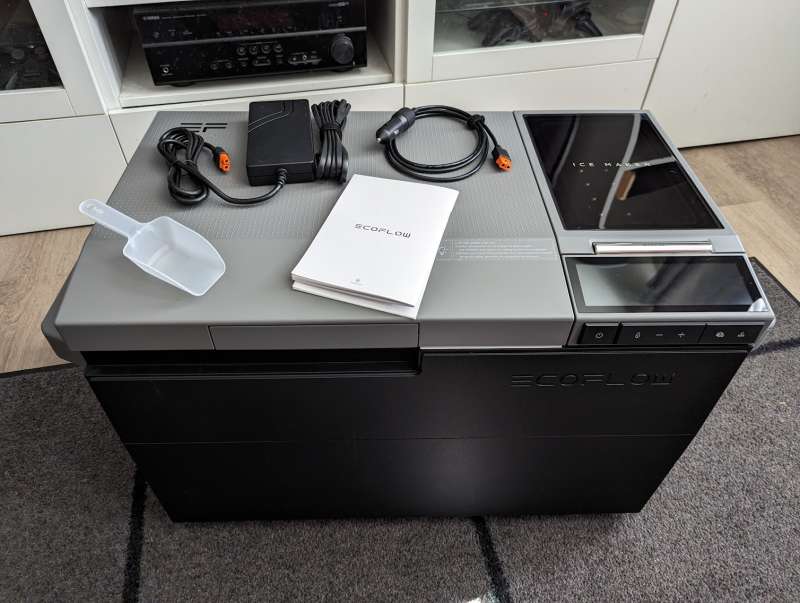
Design and features
From first glance, it’s clear that a lot of thought went into the design of the EcoFlow Glacier. From its sleek muted black and gray color palette to the subtle embossed logos on its body, the Glacier gives the impression that it would be better suited cruising on a luxury yacht than bumping along a dusty trail.
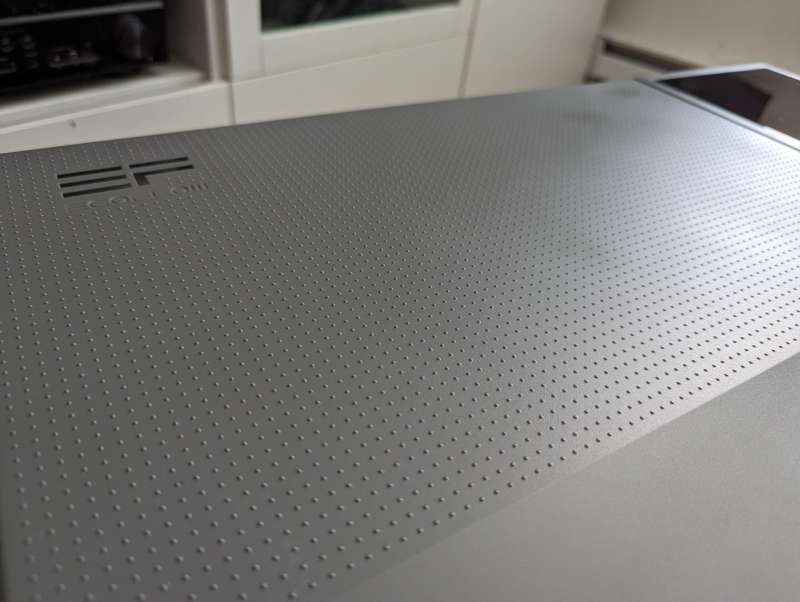
The lid is well-textured to prevent items from slipping off when using the Glacier as a table.
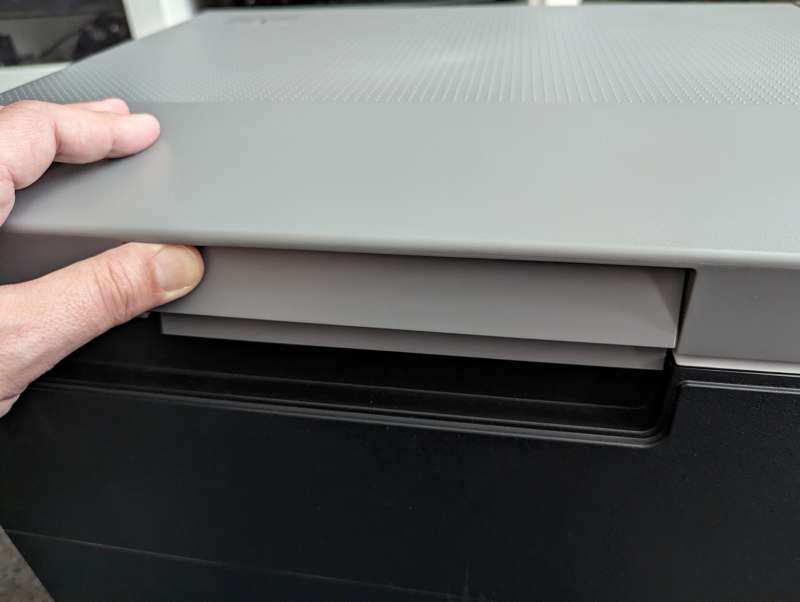
The lid’s latch has a nice tactile feel to it and is designed to unlock the lid with ease when you push in on it and lift.
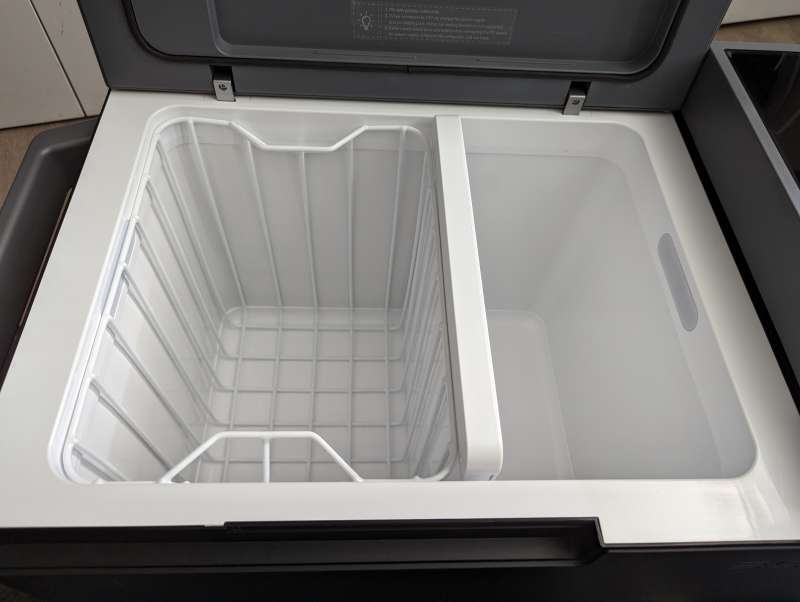
At first, the 38L interior of the Glacier doesn’t look as spacious as you expect. That’s due to the thick, insulated walls of the unit and the removable divider, all designed to keep contents cold even when the compressor isn’t engaged. In its dual-zone configuration, both sections can refrigerate and freeze from 50°F (10°C) to -13°F (-25°C), allowing one side to be used as a fridge and the other as a freezer.
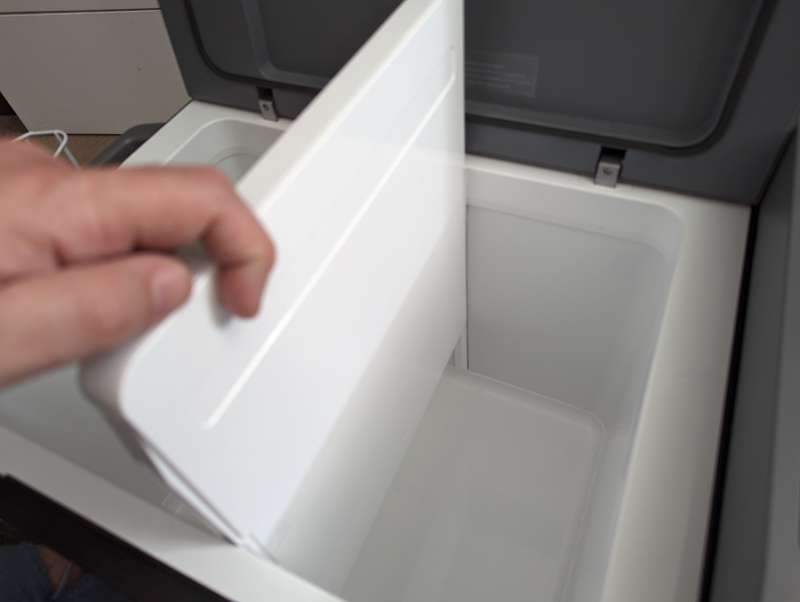
One great feature of the Glacier is that when you remove the zone divider, the unit automatically changes the temperature controls from dual-zone to single-zone mode.
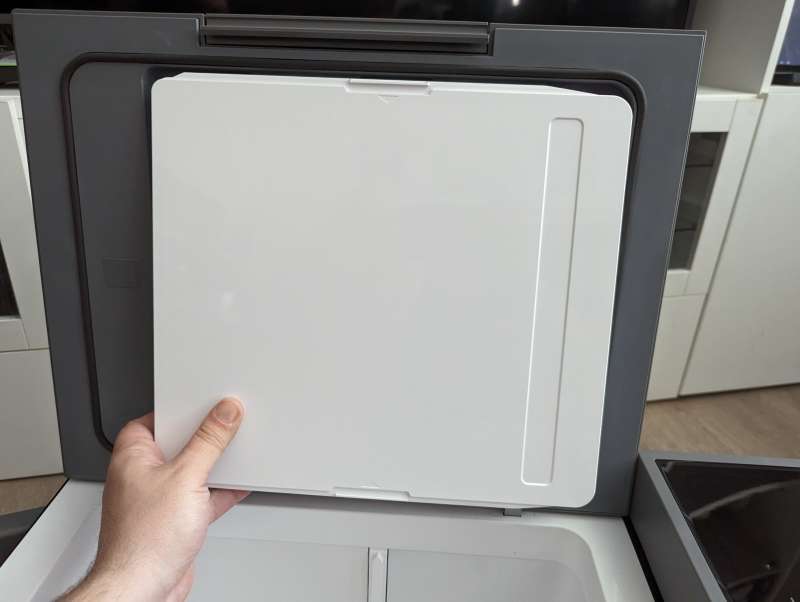
What’s even more impressive is that there’s a section in the lid to store the divider after you remove it.
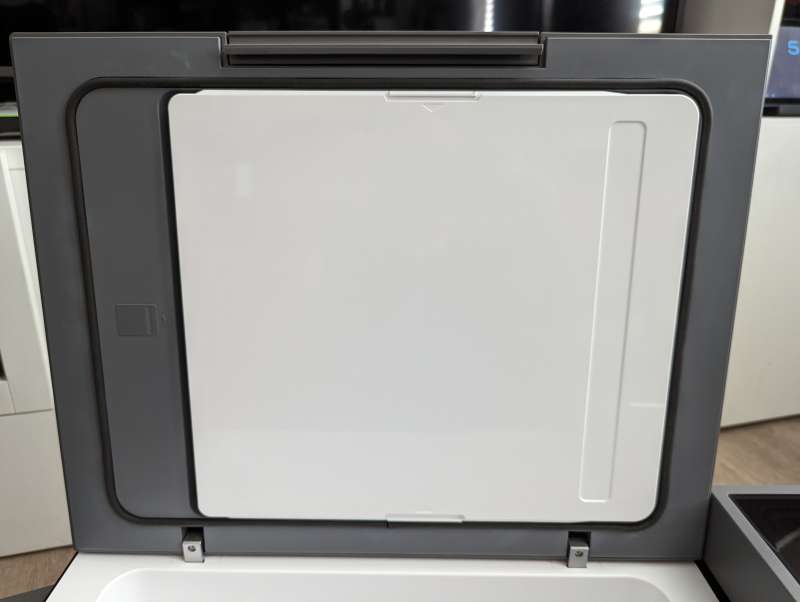
This type of deliberate design flourish is what sets the Glacier apart from other fridge freezers in its class.
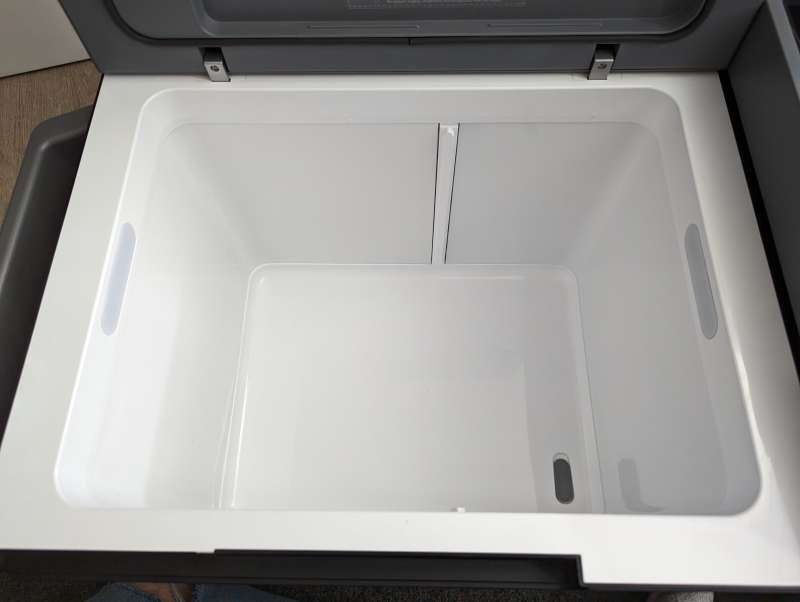
With the full 38L of space available, the Glacier works really well as a high-end cooler for drinks or a below-zero freezer for BBQ meat.
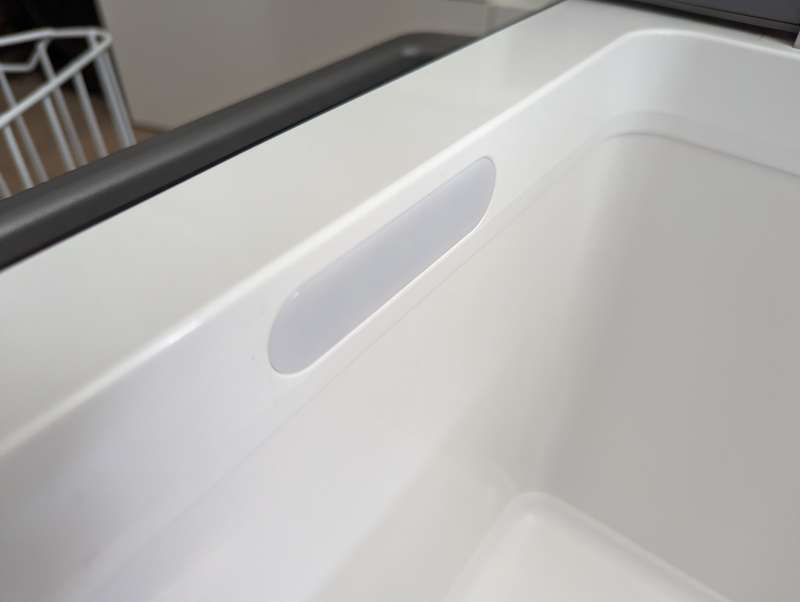
For grabbing beverages from the Glacier in the dark, there are handy LED interior lights on either side of the interior.
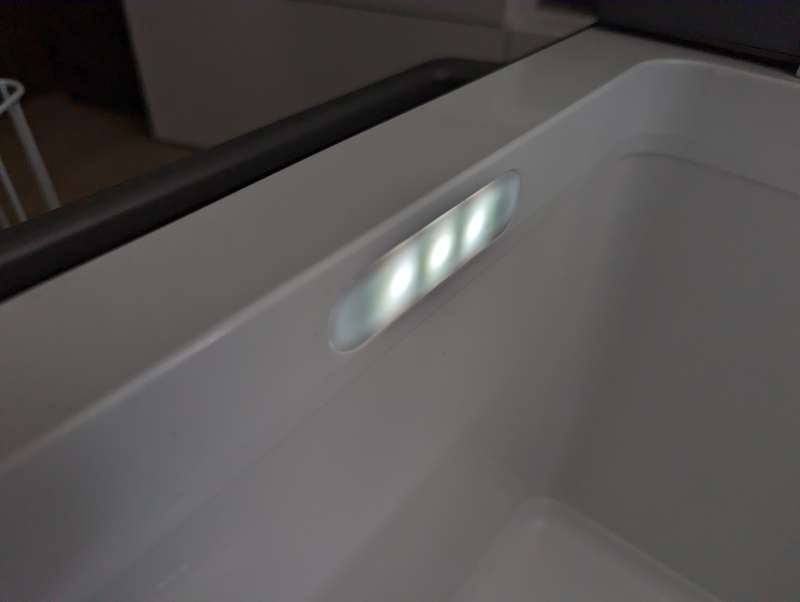
The lights are surprisingly bright, and honestly, I don’t want to go back to using unlit coolers ever again.
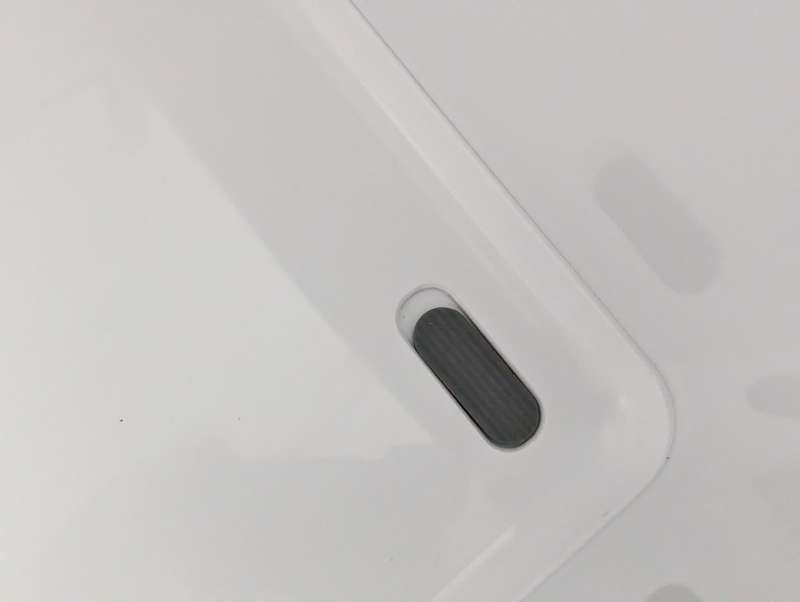
At the bottom of the interior is a small detachable rubber drain plug.
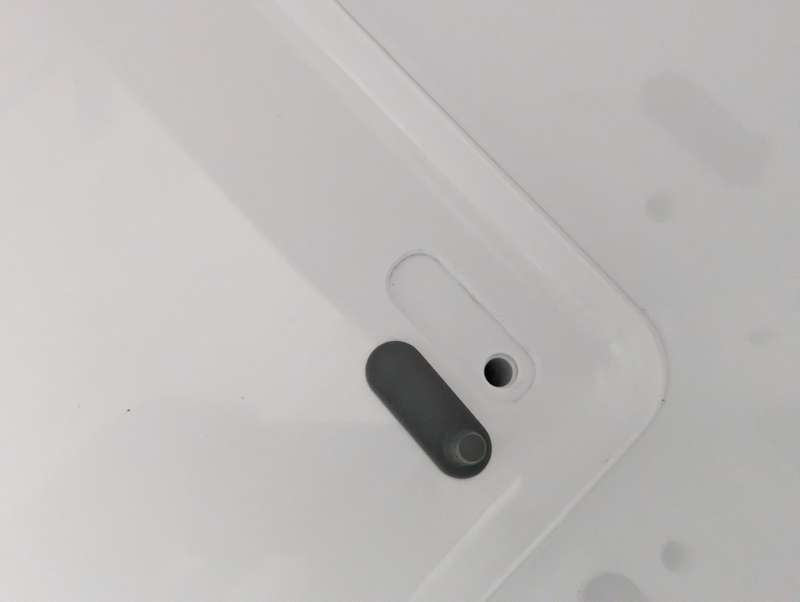
I’d prefer it if the plug remained attached to the unit during draining so it doesn’t get lost. However, since this type of fridge freezer isn’t designed to hold liquid on the interior like a cooler would, I hopefully won’t have to use the drain very much.
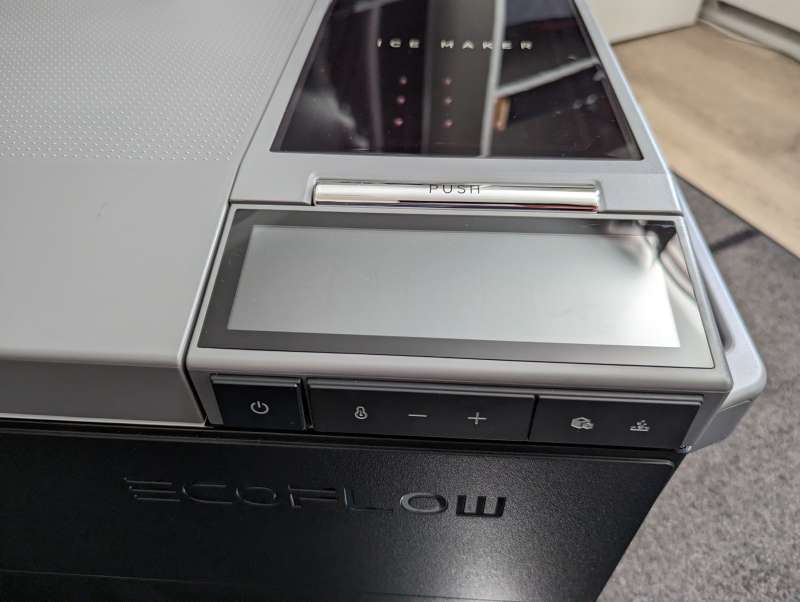
Back on top, to the right of the lid are the EcoFlow Glacier’s controls and screen. There are three large control areas with six buttons: power, temperature zone selection, temperature increase/next button, temperature decrease/previous button, ice-making button, and an ice detaching/cancel button.

The bright LED display shows the temperature of both zones as well as the battery’s charge level if attached and ice making time remaining when activated.
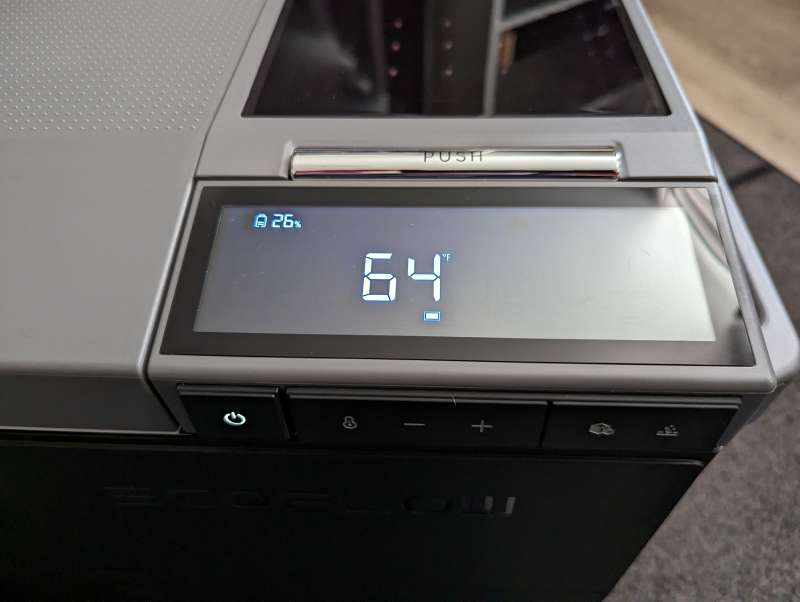
When the interior divider is removed, the screen switches to display a single temperature for the whole unit.
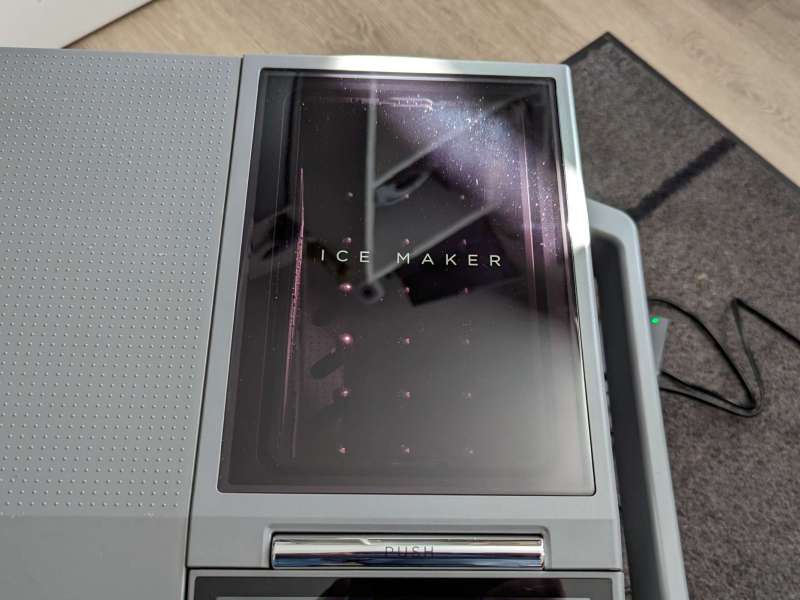
Just above the display is the most interesting feature of the EcoFlow Glacier portable refrigerator, the integrated ice maker. First, let’s talk about the lid. EcoFlow chose to make the lid of the ice maker out of thin, transparent plastic, which, in my opinion, was a huge mistake. The plastic feels flimsy, and I’d doubt it would last long without breaking while off-roading on a bumpy trail. Also, since the Glacier informs you when the ice maker has completed its cycle, both visually on the display and with a very loud chime, I have no idea why a thin, plastic, see-through lid was required here.
Additionally, the large push button for the lid seems to activate if you so much as look at it. This became so annoying that I ended up taping the lid closed to prevent it from opening every time I accessed or moved the Glacier.
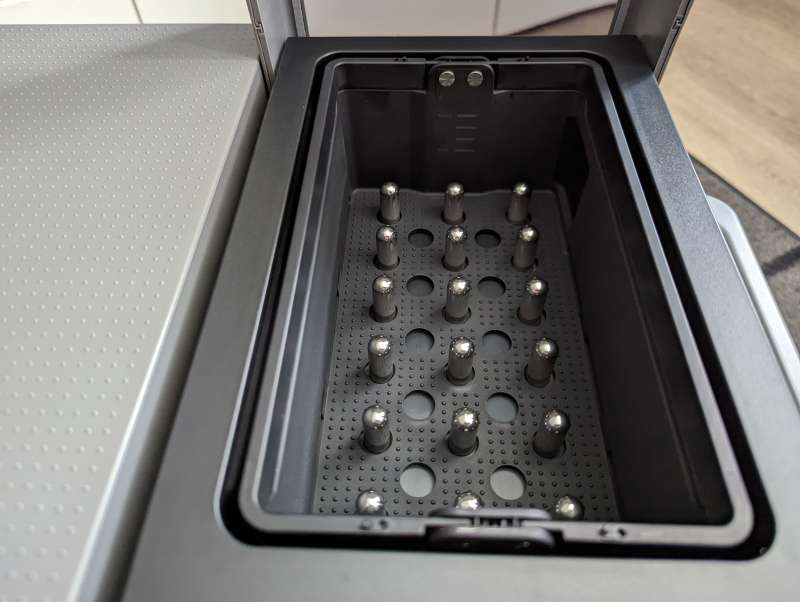
Under the lid, you’ll find 18 metal studs that, when immersed in water and chilled by the Glacier’s compressor, generate ice on demand. One downside to this system is that while the compressor works on making ice, it stops cooling the interior of the Glacier. Since making ice takes only around 12-18 minutes in my testing, this isn’t a major issue since the interior is well insulated. But, to maintain efficiency, it’s best to not open the lid of the Glacier until the ice making is complete if possible.
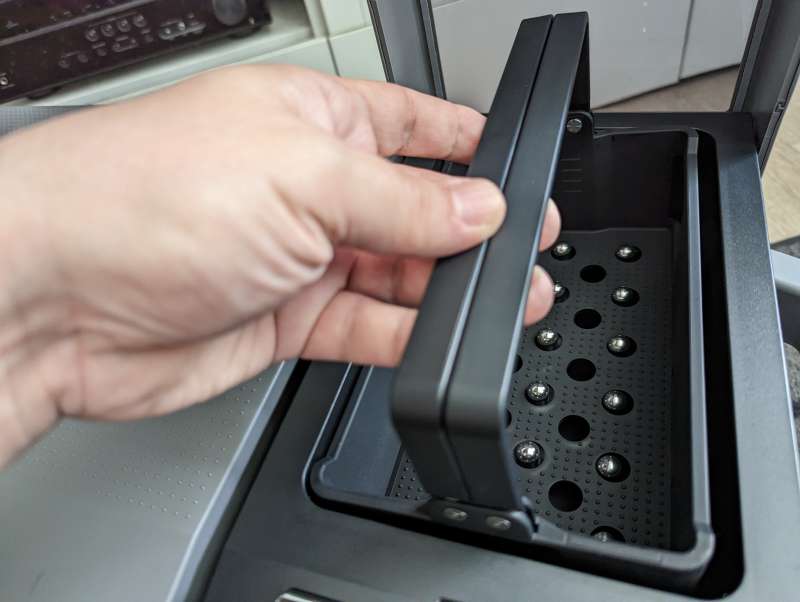
Basically, this system functions similarly to household ice makers. But, instead of the studs pointing downwards and releasing the ice once it’s formed, in this system, you pull up on a basket to detach the ice from the studs.
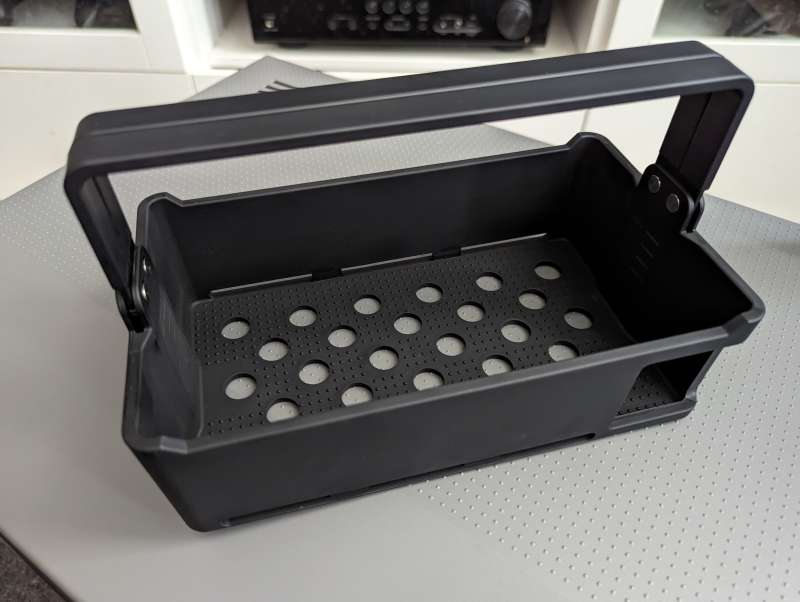
The basket has 18 holes in the bottom and a folding handle that sits flush against its sides when not in use. There’s also a large opening in one corner of the basket to facilitate ice removal.
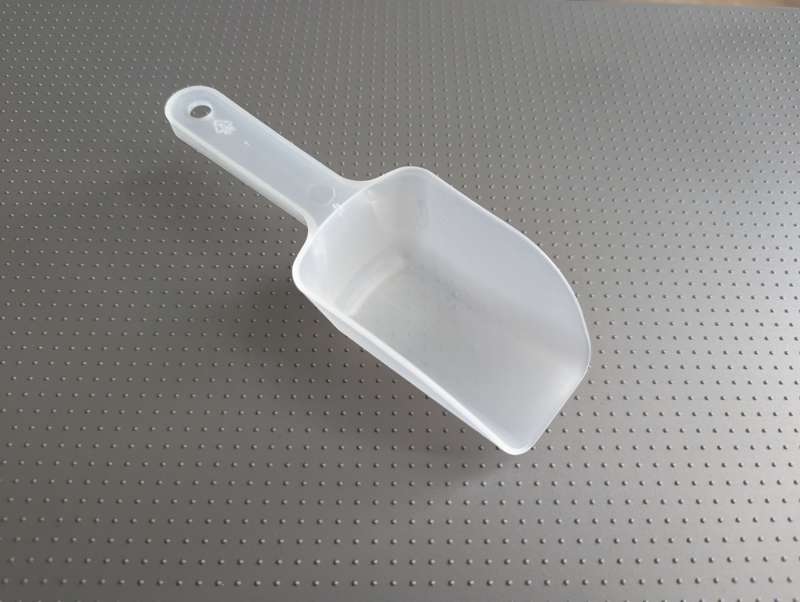
EcoFlow includes a tiny “ice shovel” for removing ice from the basket, but honestly, this was less than useless in practice.
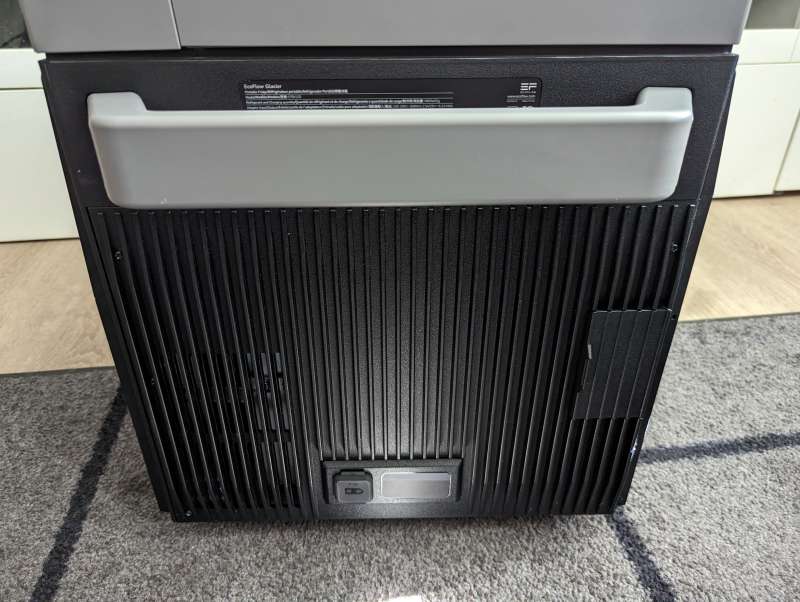
Both sides of the Glacier have large carry handles that can be removed if needed.
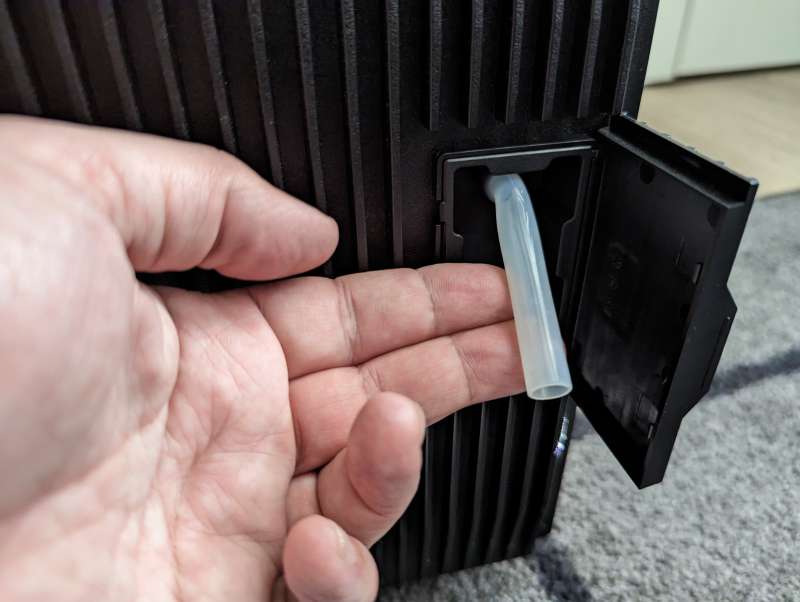
There’s a small door on the right side that when opened reveals a small drainage tube used to empty water from the ice maker.

On the bottom of the right side of the Glacier is the power port for connecting AC power, DC power, or the EcoFlow Solar Panels, which are sold separately. An important thing to note about the optional Solar Panels is that they will work only if you have the portable rechargeable battery, which is also sold separately.
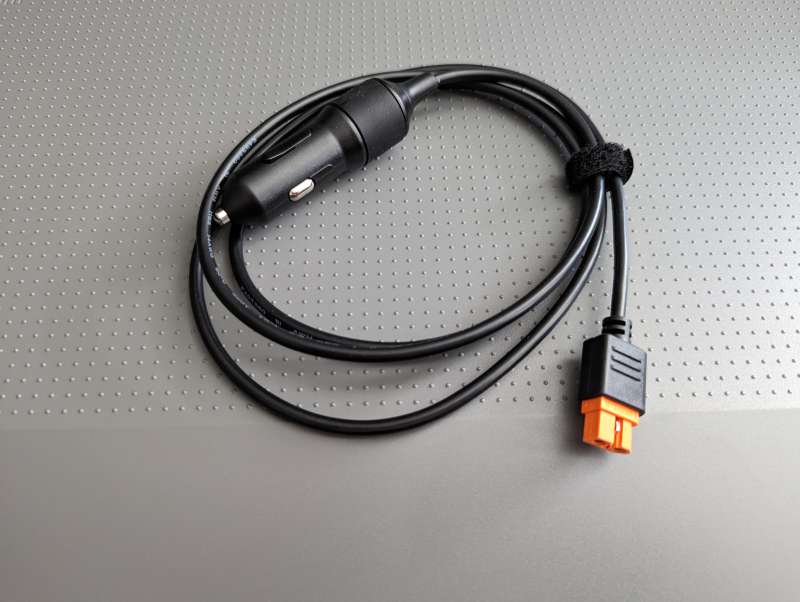
The DC 12V power cable is included with the Glacier, although I wish it were a bit longer. The Glacier can be fully charged by DC power in about four hours, and via the Glacier app, you can enable a battery protection feature to keep from accidentally draining your 12V power supply. With battery protection turned on and the portable battery installed, if the supply voltage falls below a set level, the Glacier will automatically switch to supplying power via the internal portable battery instead.
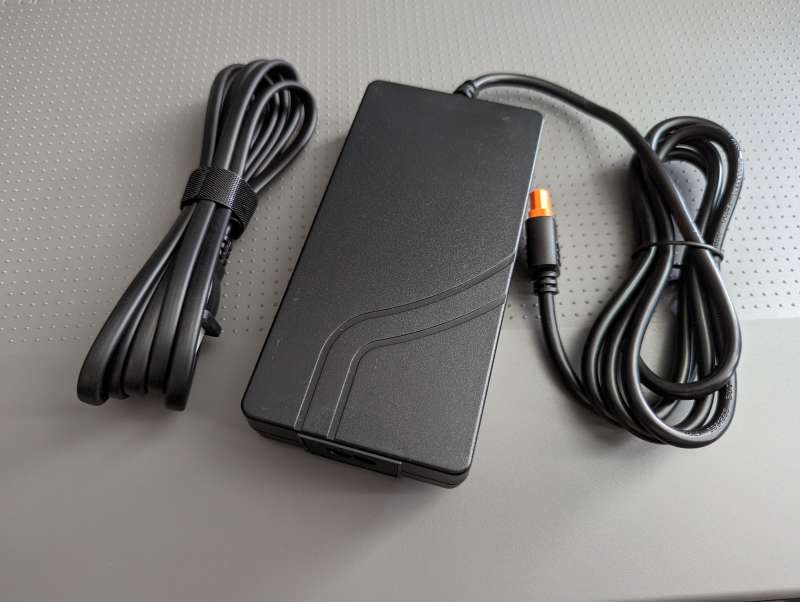
The included AC power cable has a decent-sized power brick and will fully charge the Glacier in just over two hours.
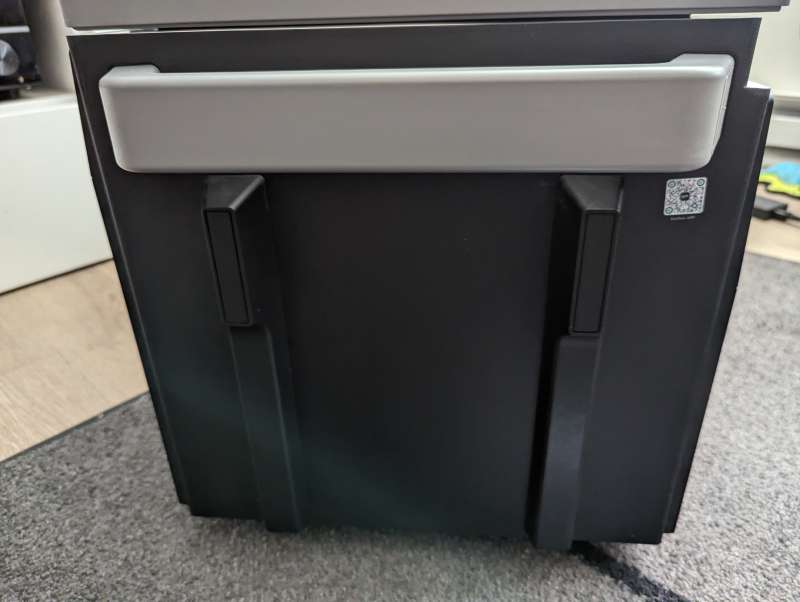
The left side of the Glacier has two long vertical rails/runners. These rails are removable only for replacing them with the optional telescoping carry handle.
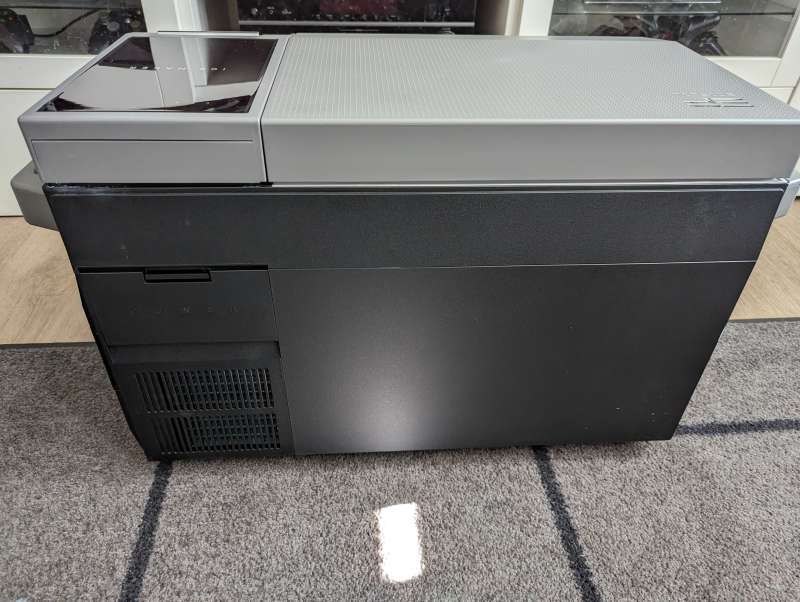
On the back of the Glacier, you’ll find the vent for the compressor, along with a small door marked ‘Power’.
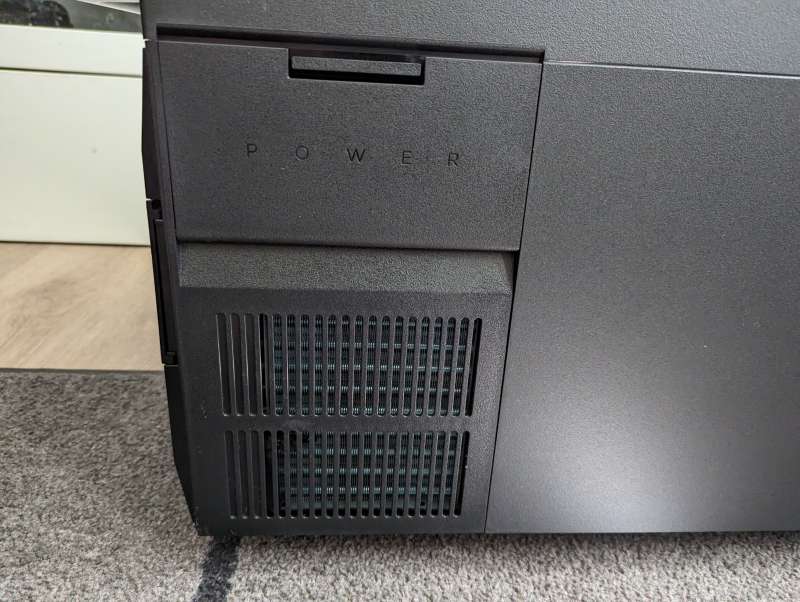
This ‘Power’ door is where the 298Wh portable rechargeable battery is stored.
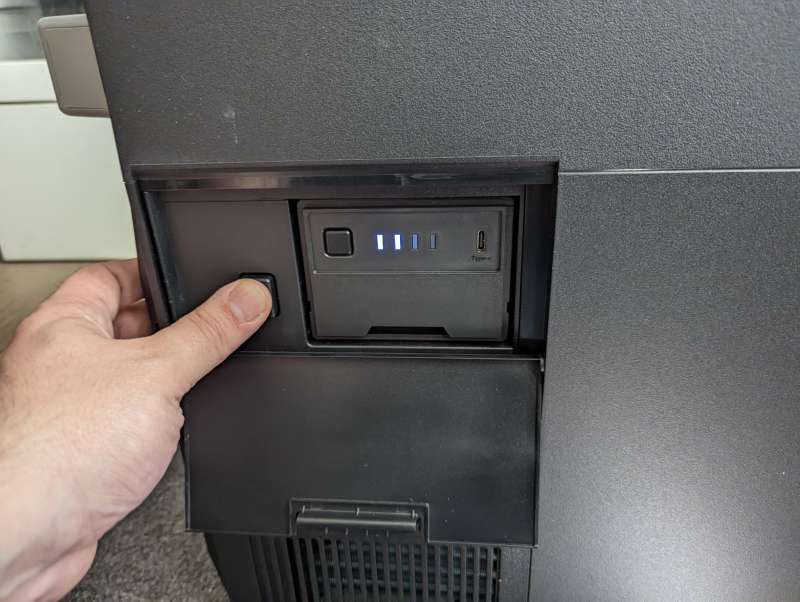
There’s a button to unlock the battery for removal and a small button on the battery itself to check its charge level.
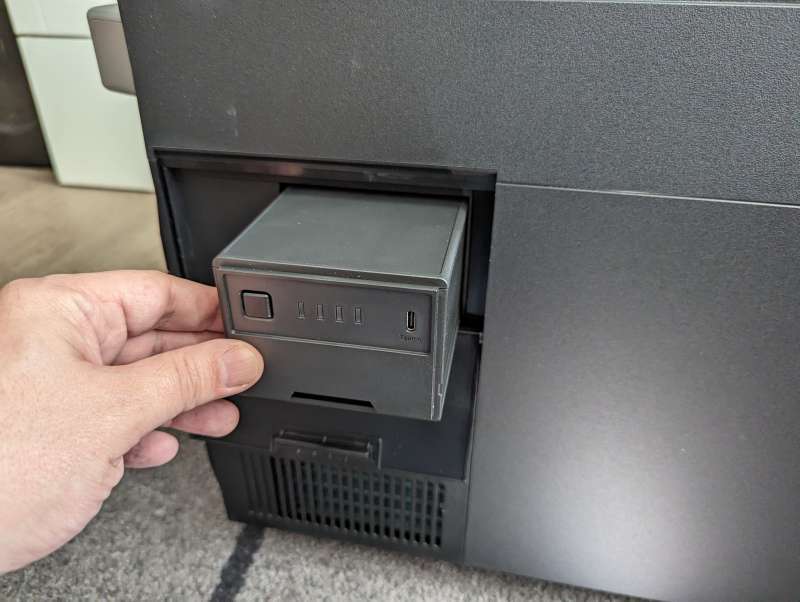
The battery slides in and out easily and locks securely in place when inserted.
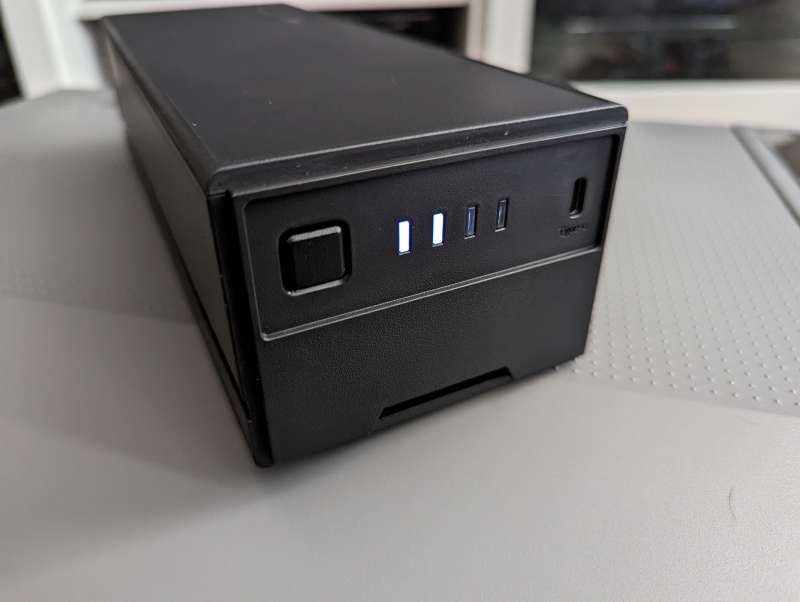
The battery has a small 100W USB-C port that can be used to charge devices like smartphones or laptops.
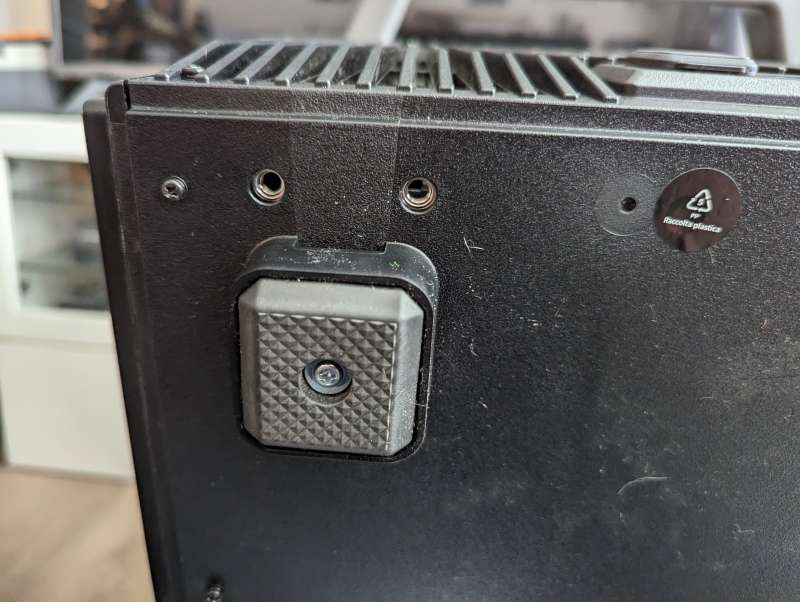
Four rubber feet on the bottom of the Glacier keep it from sliding around on slick surfaces.
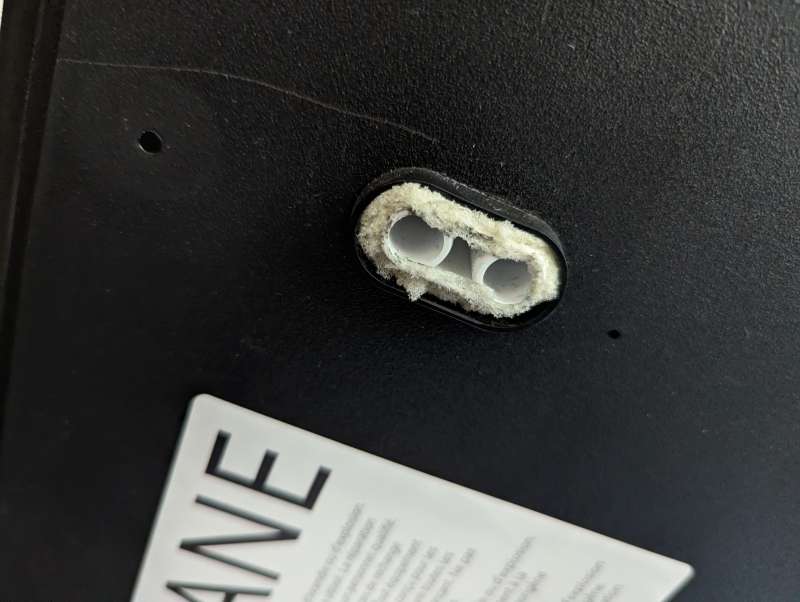
The other thing you’ll find on the bottom of the Glacier is the exit port for the main interior drain plug.
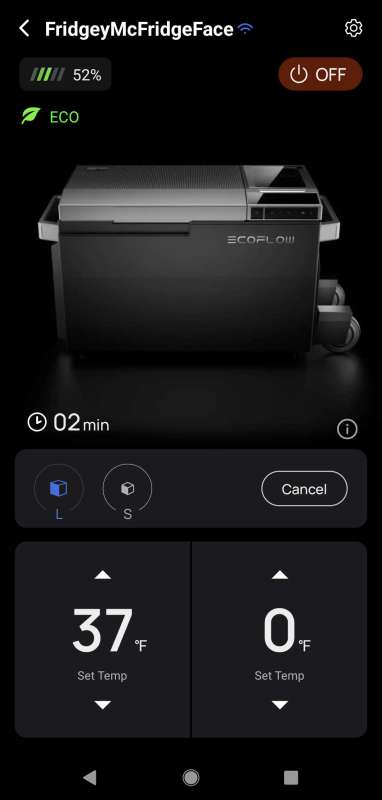
Setup
The complexity of setting up the EcoFlow Glacier portable refrigerator depends on the accessories you’ve purchased. If you have the Glacier unit without accessories, the only setup required is downloading the EcoFlow app, connecting via 2.4 GHz WiFi, naming your Glacier, and setting your preferences.
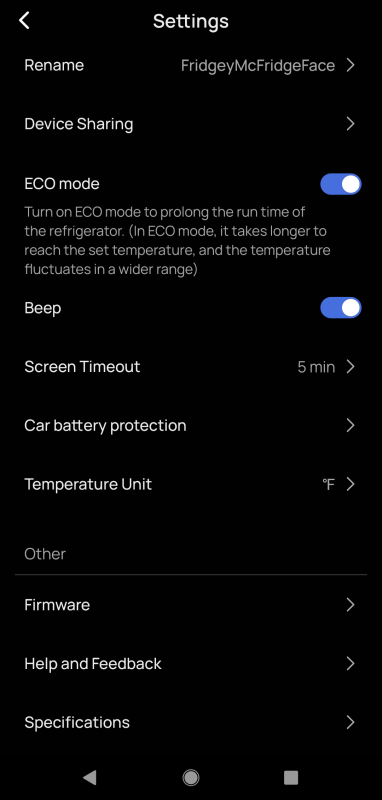
The app is really well-designed and offers a lot of control over the Glacier, which I’ll cover in the Performance section. For setup, it’s best to check that the most recent version of the Glacier’s firmware is installed since EcoFlow recently pushed out an update that improved the ice-making system a bit.
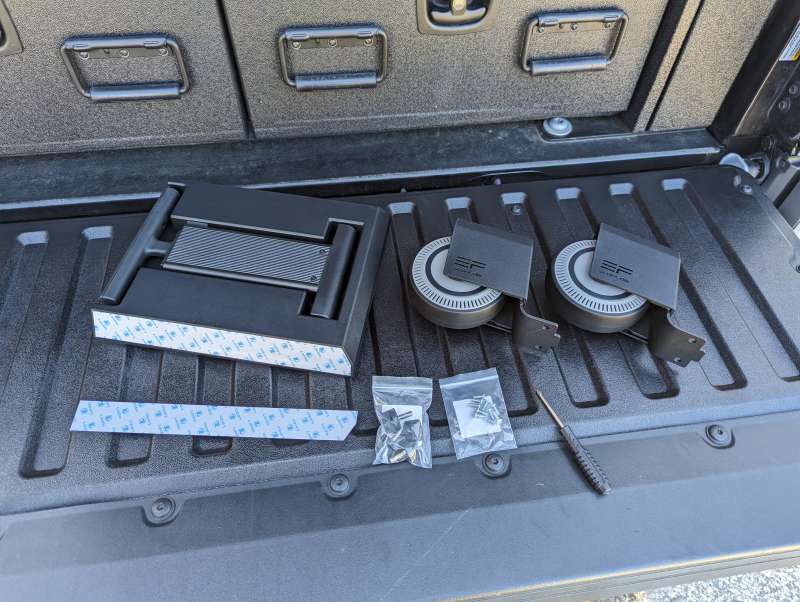
If you have the Glacier Wheels and Handle Kit, there’s a bit of assembly required.
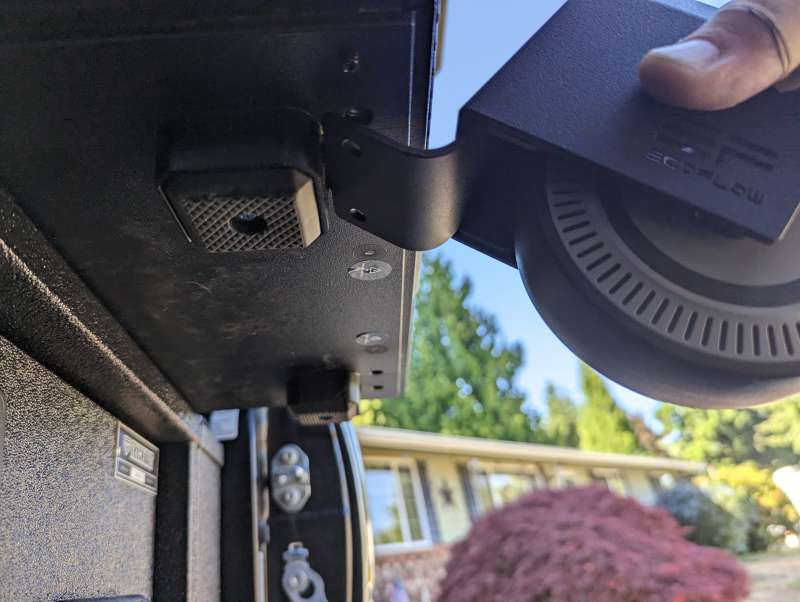
The wheels attach to the bottom of the Glacier’s right side and align with four pre-made holes.
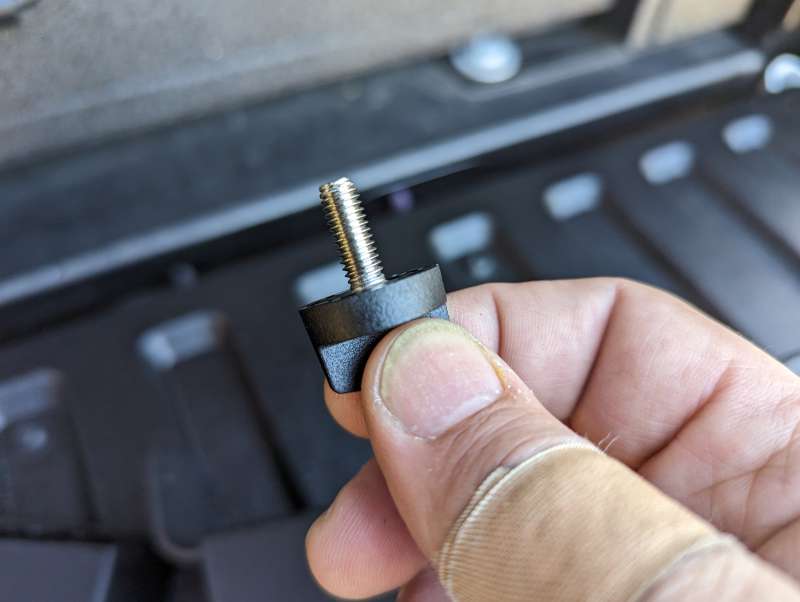
EcoFlow includes four bolts for the wheels that can be attached and tightened by hand.
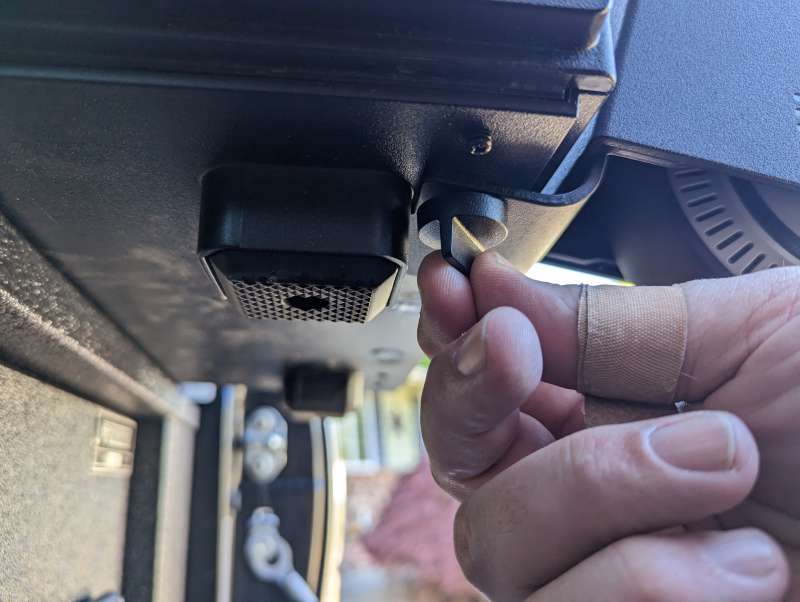
I used a bit of blue thread locker on the bolts just to make sure they stay put, but even just hand-tightened they felt secure.
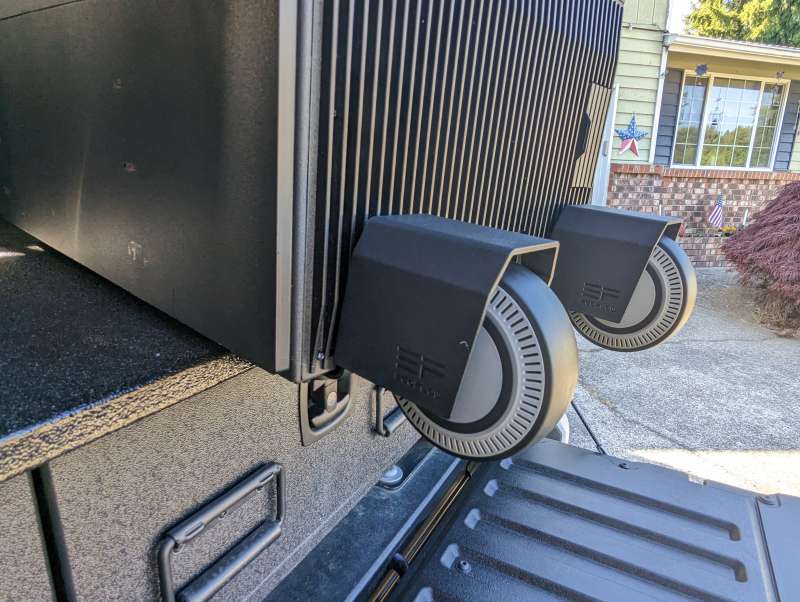
The wheels do extend pretty far from the body, which makes the Glacier take up more space, but they are quite hefty and smooth-rolling.
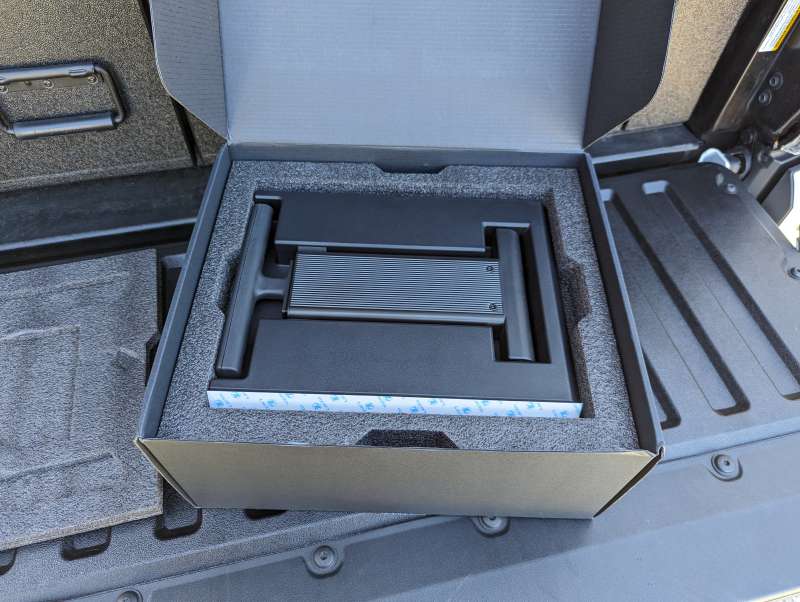
The telescoping carry handle attaches to the left side of the Glacier, but you have to prep that side first.
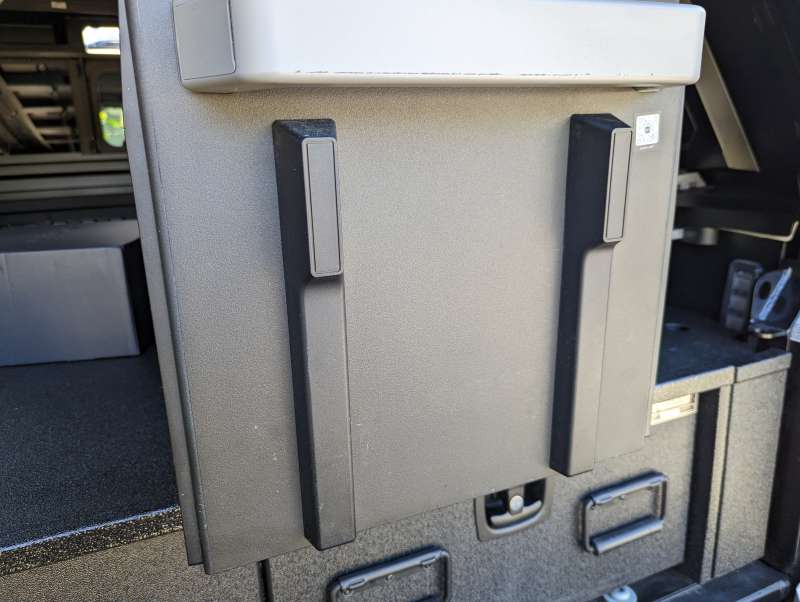
The two rails/runners need to be removed before the carry handle can be installed.
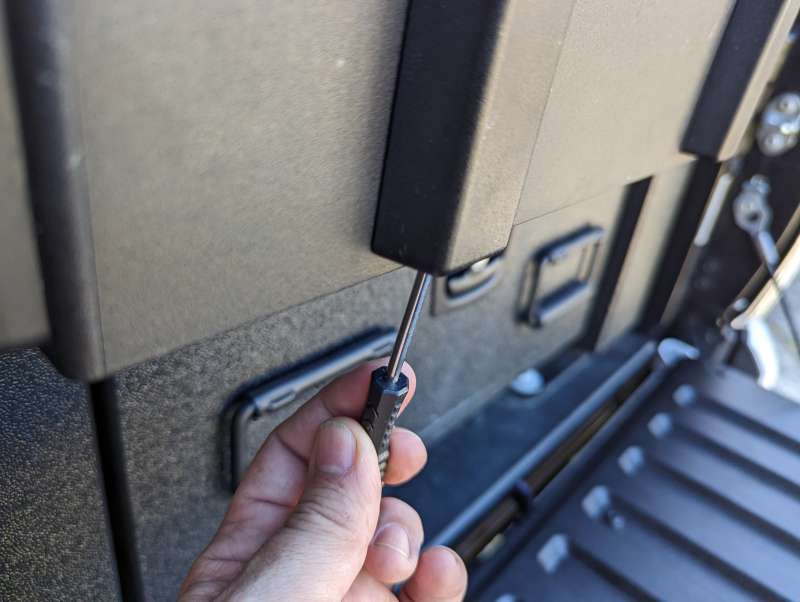
EcoFlow provides a small Phillips-head screwdriver to remove the two screws holding the rails in place. Once removed, the rails lift up and off of the Glacier.
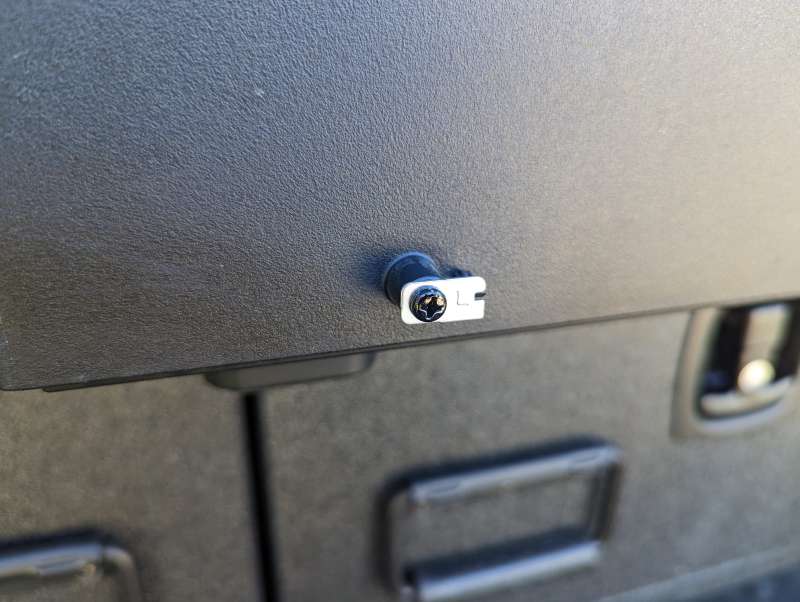
Two additional small screws and brackets need to be removed from the bottom of the Glacier after the rails are taken off.
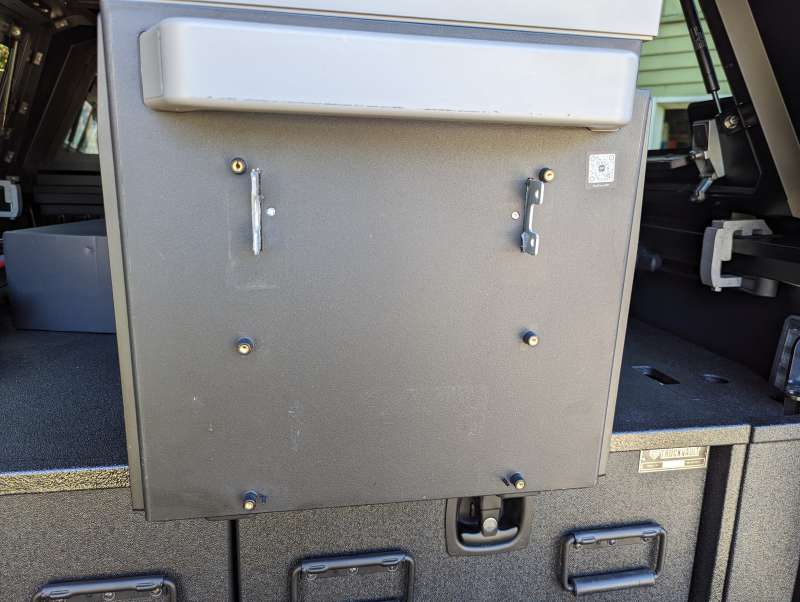
The brackets and attachment points used for the rails will now align with the carry handle.
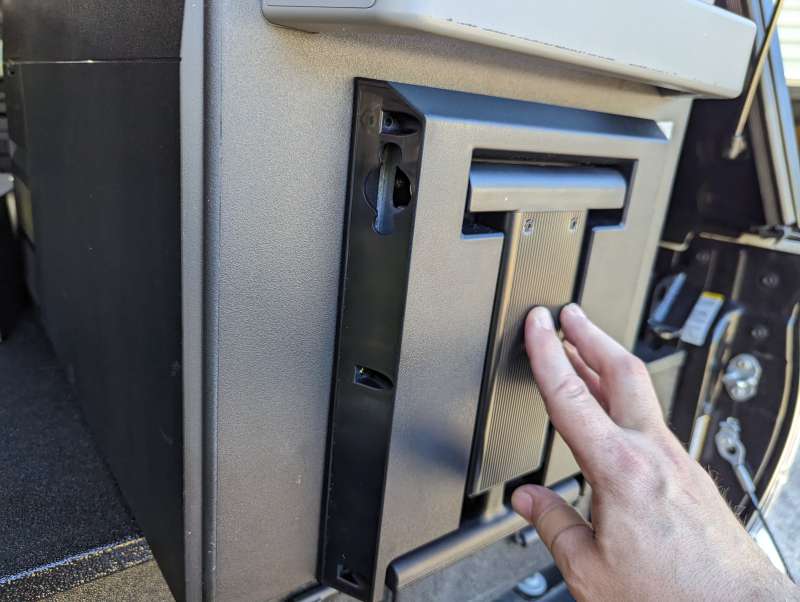
The whole handle system fits perfectly flush to the Glacier.
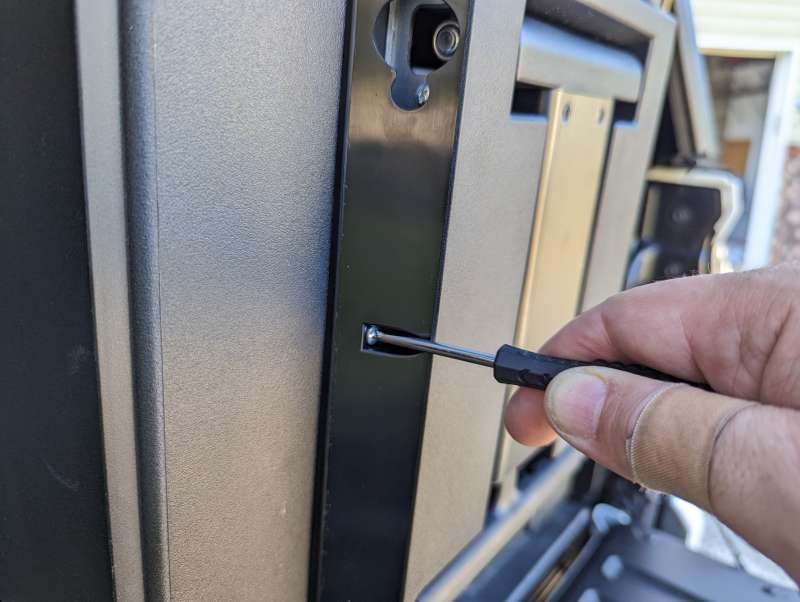
Once the holes are lined up, it takes six screws on the front to attach the handle.
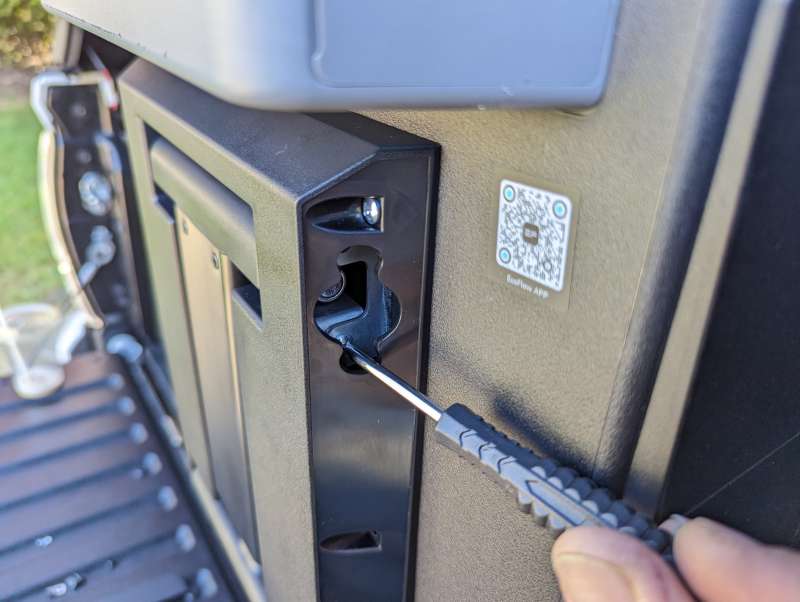
Four more screws, two on each side, further secure the handle to the Glacier.
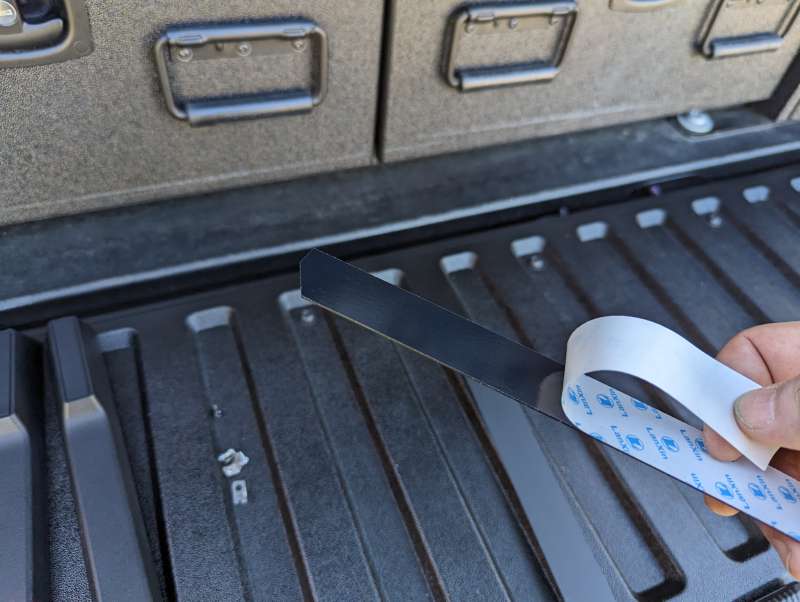
EcoFlow provides two long plastic strips with adhesive backing to fit over the screw holes of the carry handle.
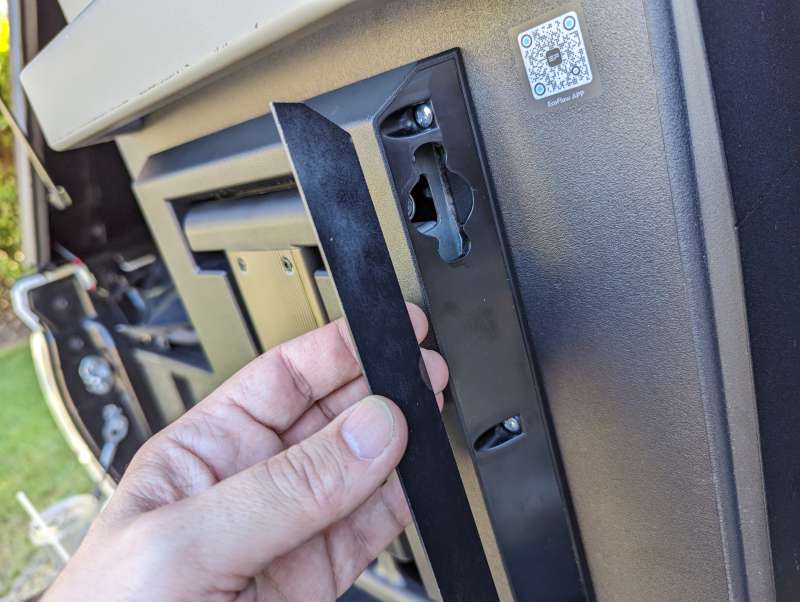
The strips are cut specifically for the right and left side of the handle.

With the strips in place, the carry handle looks and feels like it was always part of the unit.
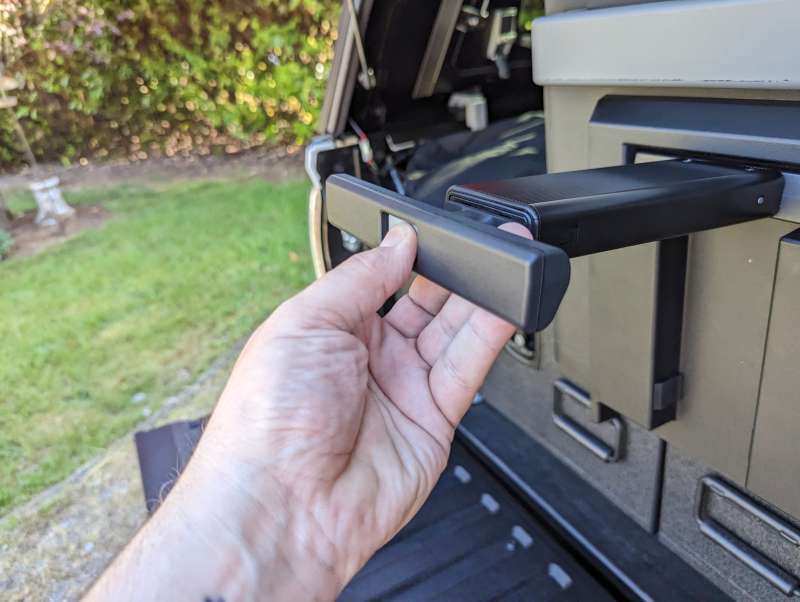
The handle works like those on wheeled suitcases, pushing in on a button in the handle unlocks the handle to its full length.
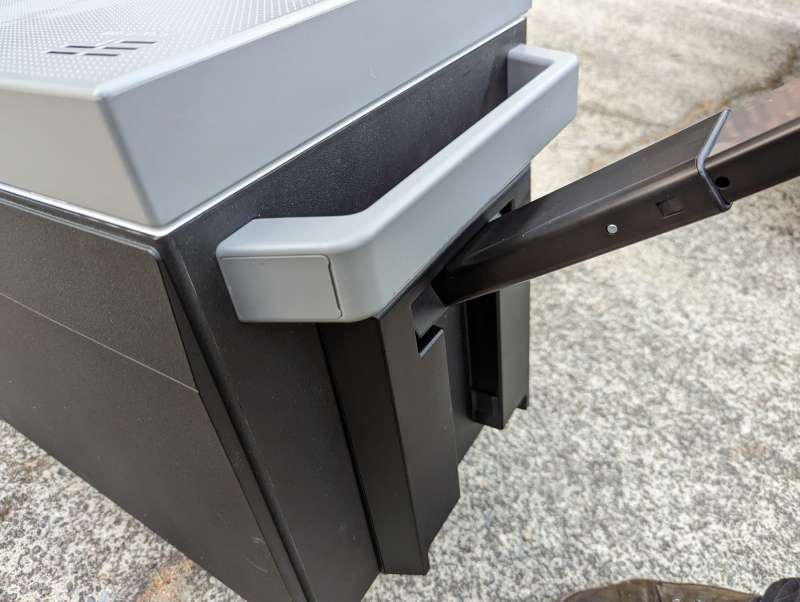
The handle feels very strong, which is good because the Glacier weighs about 50 lbs. empty.
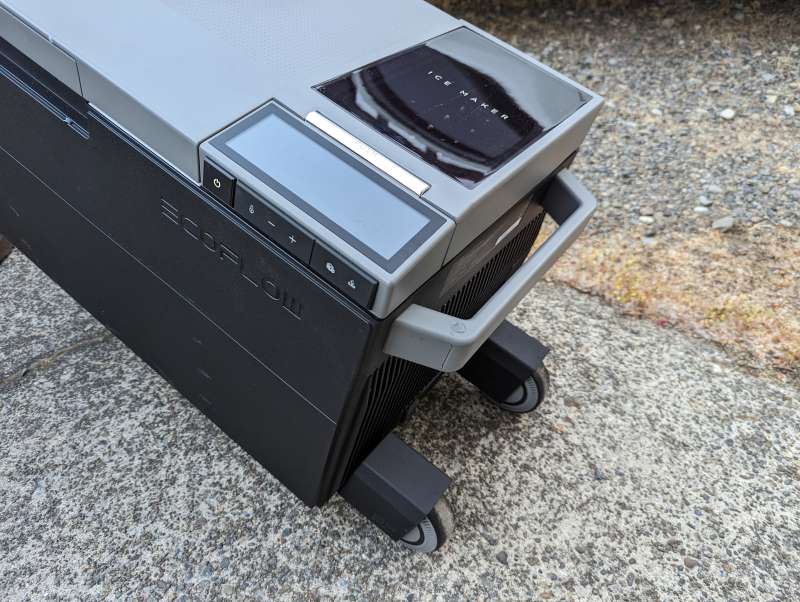
I originally wasn’t going to keep the wheels and handle on the Glacier, but after seeing how much easier it makes moving the unit around, I decided to keep them attached.
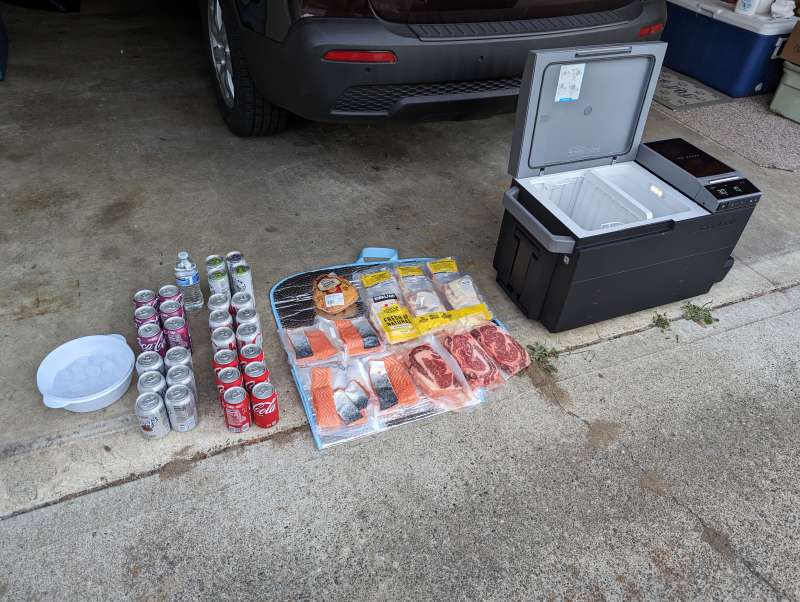
Performance
The EcoFlow Glacier really shined during testing. The high price was definitely reflected in the impressive efficiency, ease-of-use, and effectiveness of the Glacier as a portable fridge freezer.
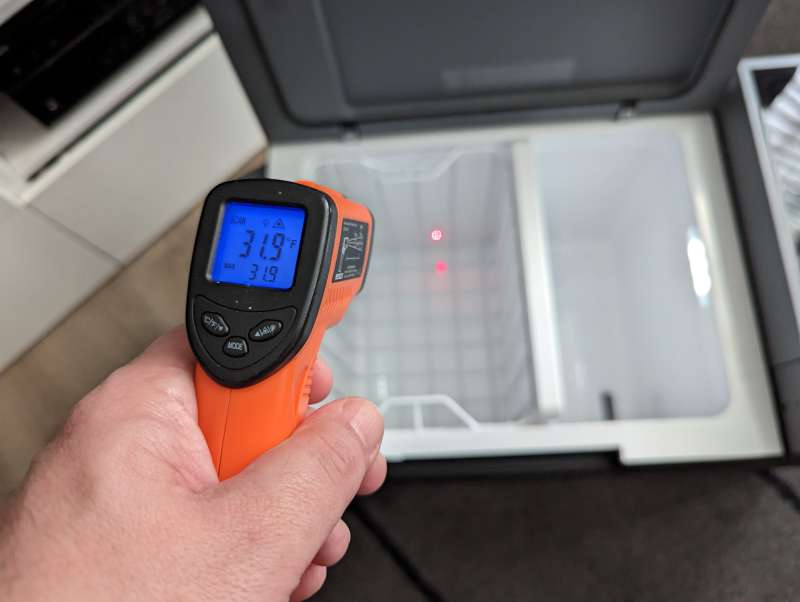
True to EcoFlow’s claims, the Glacier cooled itself down from room temperature to about 30°F on one side and -2°F on the other in less than 15 minutes when empty.
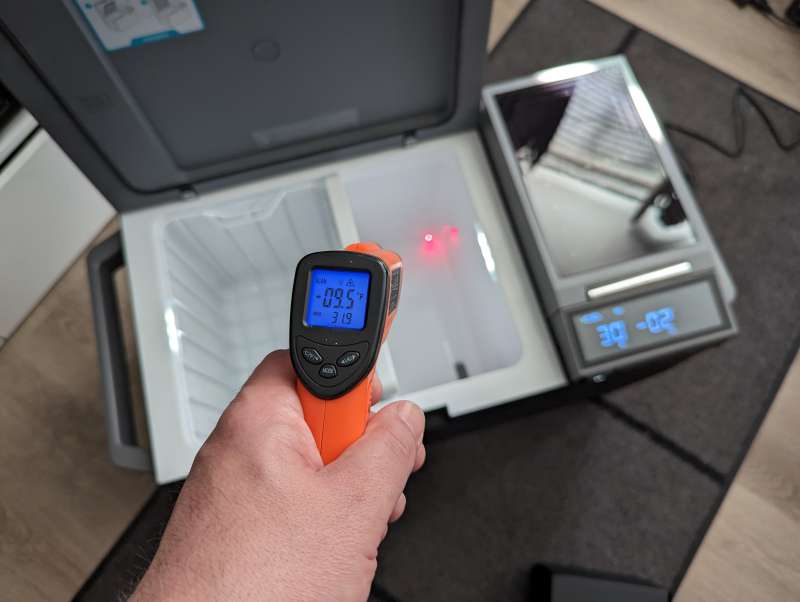
During this Quick freezing mode, I had to check to see if the Glacier was running a few times because I couldn’t believe how quiet it was.
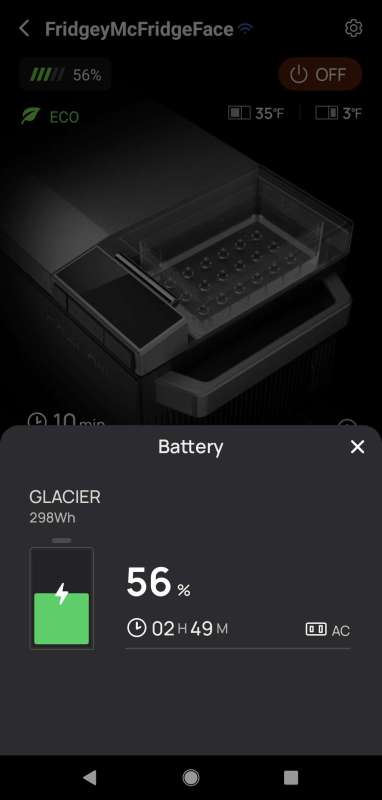
The app performed equally well, presenting all of the info I needed in an easy-to-read, well-designed format. From the app, I could turn the unit on or off, change the temperature of either zone, check the battery level and charging time, and initiate or cancel the ice maker. All without a single crash or hiccup common with most apps for the devices I review.
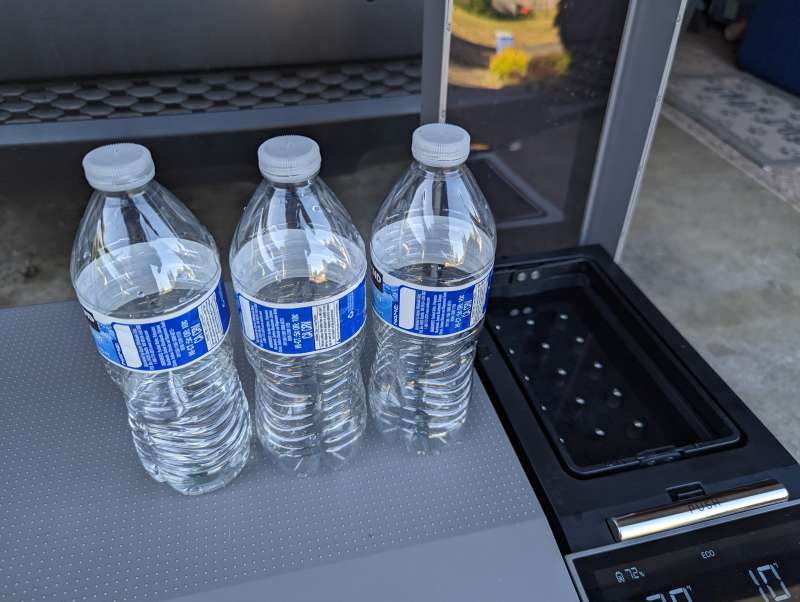
The ice maker also worked very well, and while I was at first skeptical about its usefulness, it won me over the first time I was able to chill a drink I had left out too long. Operating the ice maker is easy, and it takes about two and a half regular water bottles to fill it up to its max level.
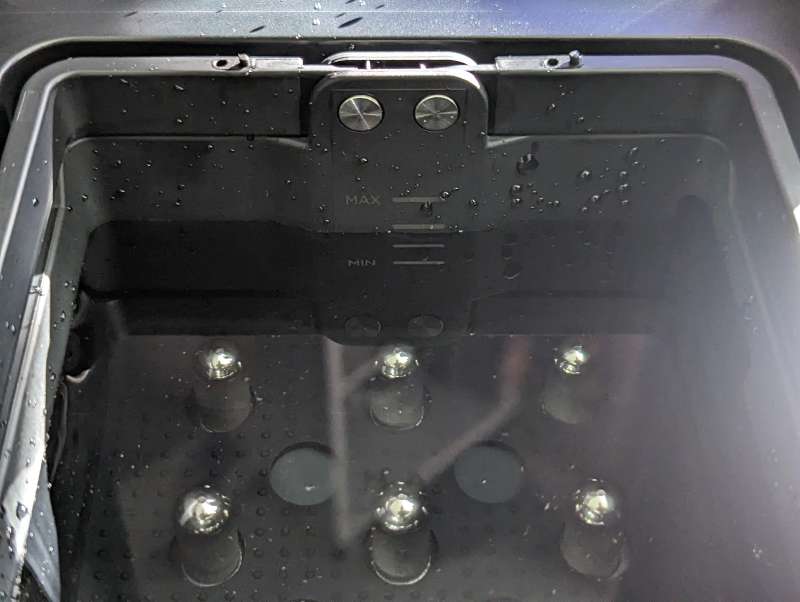
Once filled, I just kept the water in there after each batch of ice and topped it off once it dipped below the minimum level.
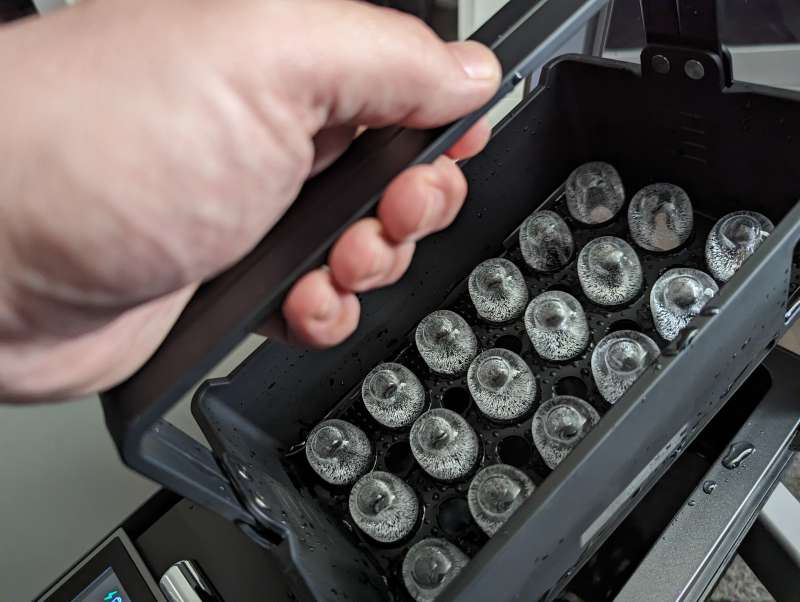
The basket would initially stick to the interior of the unit even after the app indicated that it was ready to be detached, but after a few batches, it became easier to remove.
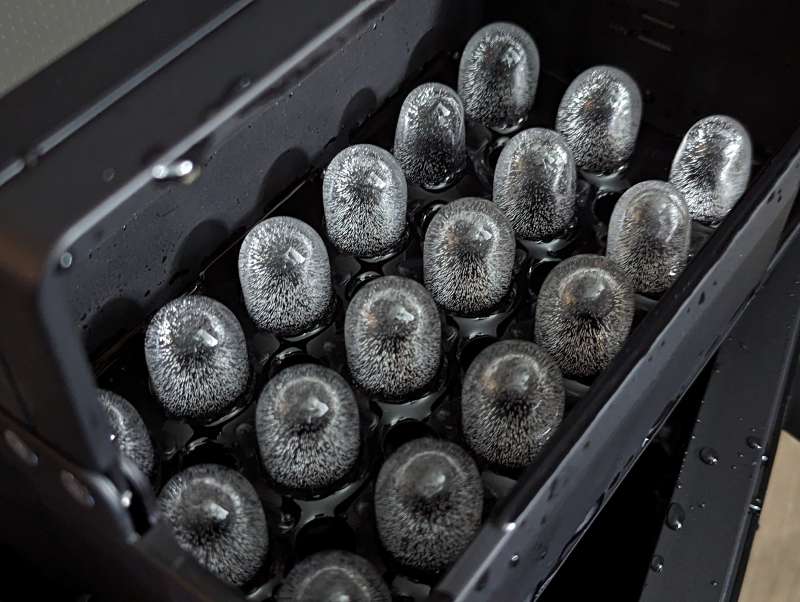
The ice cubes were on the small side but served my needs well since I was only using them in my drinks and water bottle and not to keep a weekend supply of food fresh.
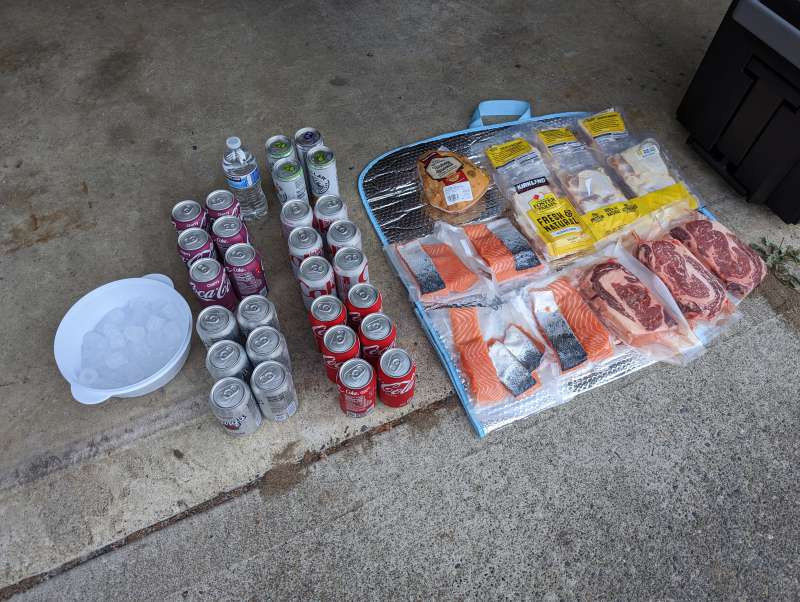
Besides the ice maker’s performance, the volume of the EcoFlow Glacier surprised me as well. Even using it in dual-zone mode with drinks on one side and meat on the other, I was able to fit an incredible amount of supplies. Not only did the food fit, but the freezer side was able to keep the temperature down below zero so that items were kept frozen solid until I was ready to defrost them.
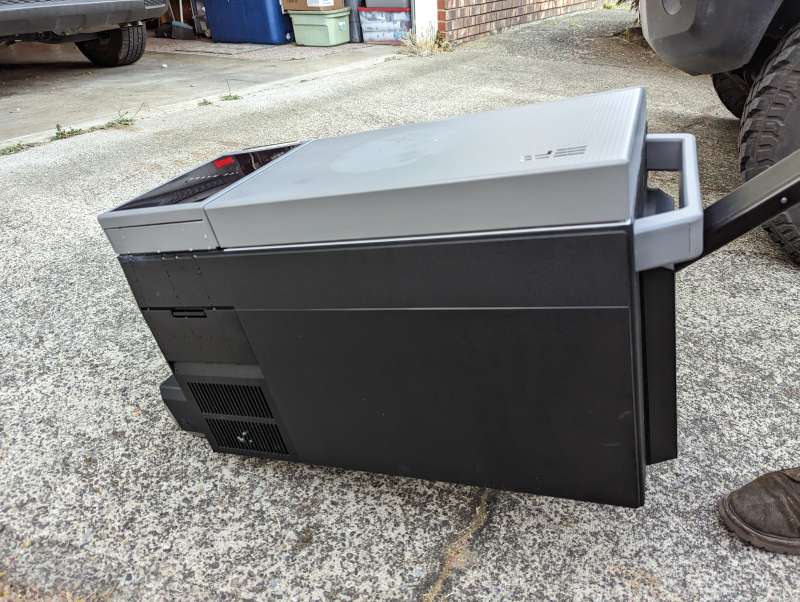
Adding the wheel kit made lugging all of that food around camp a lot easier, and now I can’t imagine using the Glacier without the wheels and handle. I do feel that these should be standard for the Glacier and not an optional add-on you have to purchase.
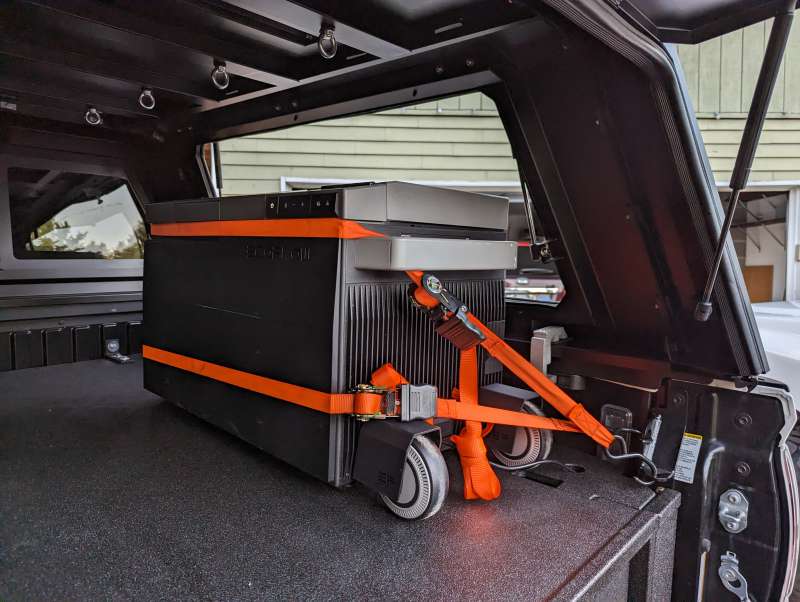
After securing the Glacier in my Overlanding rig, I was pretty confident that it would make my time on the trail a bit more enjoyable. I was very conscious of the breakability of the ice maker lid the whole time, but that anxiety was offset by the joy and convenience of having on-demand ice whenever I liked. Overall, I really enjoy using the Glacier, and I am very happy with its performance as a fridge freezer, but that should be a given at this high of a price.
What I like
- Excellently designed app
- Option to switch between single and double zone provides plenty of storage
- Various ways to power the unit, including a portable rechargeable battery
What I’d change
- Portable battery, wheels, and carrying handle should be standard
- Ice maker lid is fragile and constantly opens
- Build quality is not very durable
Final thoughts
The EcoFlow Glacier portable refrigerator has a lot of great features, including an integrated ice maker, a removable rechargeable battery, and the ability to be powered by various sources, including solar panels. I believe that the rechargeable battery should be included as a standard feature, though, rather than a separate add-on. The same goes for the detachable wheels and carrying handle. Both of these add-ons significantly increase the price of the Glacier to about $1,300. Considering that high price point, I would also expect the Glacier to have a more rugged design. Despite its sleek and modern appearance, the exterior of the Glacier is not as tough as I’d prefer. I doubt the ABS plastic sides or the thin plastic panel on top of the ice maker would be able to handle much abuse. I was also frustrated that I had to tape the ice maker tray closed because it kept opening whenever I handled the unit. The durability issues may not be a problem for those who plan to use it lightly, though, like for basic car camping, boating, or by the poolside. There’s no denying that there’s impressive technology behind the Glacier, and a lot of effort was spent to add features and functionality most portable fridges don’t have, making this a great purchase if you can afford it.
Price: $1,199 for EcoFlow Glacier with Rechargeable Battery, $99 for Detachable Wheels and Lever
Where to buy: EcoFlow and Amazon
Source: The sample of this product was provided by EcoFlow.


